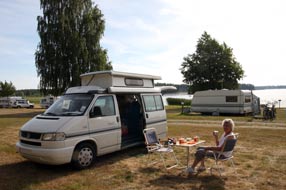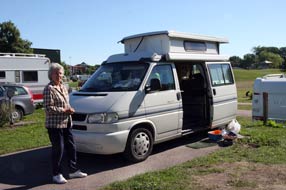|
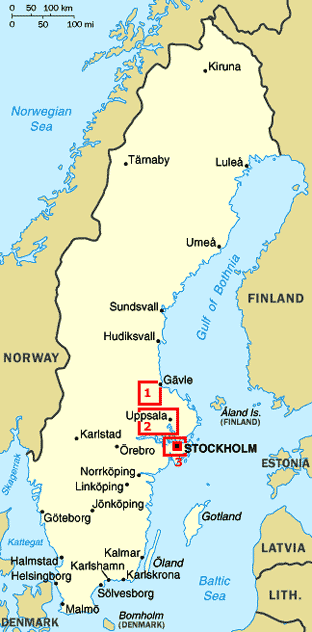 CAMPING
IN SWEDEN 2013 - the capital city Stockholm, Sweden's oldest town Sigtuna, the
royal and religious cult-centre of Gamla Uppsala, and the university-city of Uppsala: CAMPING
IN SWEDEN 2013 - the capital city Stockholm, Sweden's oldest town Sigtuna, the
royal and religious cult-centre of Gamla Uppsala, and the university-city of Uppsala:
A peaceful campsite by the Färnebofjärden
National Park:
we headed south-west from Gävle, turning off onto a minor road past Gysinge Bruk,
a former iron foundry dating from the 17th century and now the Naturum for the
Färnebofjärden National Park. Just beyond we reached the village of Österfärnebo
where a lane led along an esker ridge down through the lakeland of
Färnebofjärden, and a short distance along reached Färnebofjärdens Camping set
delightfully along the lake-shore
(Photo 1 - Lakeside camping in Färnebofjärden National Park). Here we were greeted with enthusiastic
hospitality by the Swiss owners who had recently taken over the campsite, and
gladly settled in on the lake shore as formations of Canada Geese swooped low
over the lake's still waters with the late afternoon sun just dipping behind the
pines which covered the narrowing esker. This small site set among the Färnebofjärden lakeland was wonderfully peaceful after all the noise-ridden
holiday-camps of the Bothnian coast. The evening grew dusky but stayed warm, and
for the first time in a number of weeks we sat out late with candles twinkling
on our supper table.
|
Click on the 3 highlighted areas of
the map
for details of
the Stockholm city region |
 |
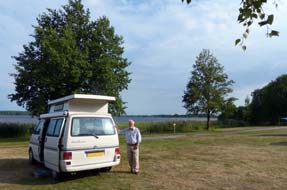 The north~south divide of the Dalälven
river: another familiar connection for us, as we
learnt from the campsite owner, is that the Dalälven river which flows lazily
through the Färnebofjärden lake system is in fact the lower continuation of the
Österdalsälven on whose banks we had camped at Idre, and which flows through
Lake Siljan on to here. The lower Dalälven broadens out into a network of
lakes and meres connected by short stretches of fast-flowing rapids, weaving
across a mosaic of riverside fens, meadows and ancient forests. During the
spring melts, flood plains spread across the flat landscape. The river had
originally flowed into the Mälaran lakes at Stockholm, but when this course was
blocked by glacial moraine, the Dalälven found a new course north-eastwards to
empty into the Baltic near to Gävle. The jagged Färnebofjärden lake system
shore-line encloses more than 2,000 islands, and the landscape of the Dalälven
now forms a natural boundary line between the boreal coniferous trees of the north and
Southern Sweden's broad leafed tree species such as
oak, beech and alder - what the Swedish botanist Carl von Linné called the Limes Norrlandicus (Northlands boundary). It also marks
something of a cultural divide between the north and south of the country. The north~south divide of the Dalälven
river: another familiar connection for us, as we
learnt from the campsite owner, is that the Dalälven river which flows lazily
through the Färnebofjärden lake system is in fact the lower continuation of the
Österdalsälven on whose banks we had camped at Idre, and which flows through
Lake Siljan on to here. The lower Dalälven broadens out into a network of
lakes and meres connected by short stretches of fast-flowing rapids, weaving
across a mosaic of riverside fens, meadows and ancient forests. During the
spring melts, flood plains spread across the flat landscape. The river had
originally flowed into the Mälaran lakes at Stockholm, but when this course was
blocked by glacial moraine, the Dalälven found a new course north-eastwards to
empty into the Baltic near to Gävle. The jagged Färnebofjärden lake system
shore-line encloses more than 2,000 islands, and the landscape of the Dalälven
now forms a natural boundary line between the boreal coniferous trees of the north and
Southern Sweden's broad leafed tree species such as
oak, beech and alder - what the Swedish botanist Carl von Linné called the Limes Norrlandicus (Northlands boundary). It also marks
something of a cultural divide between the north and south of the country.
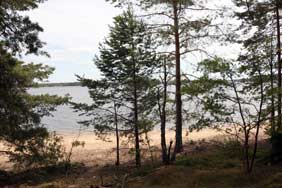 A day's walking in Färnebofjärden lakeland: Gysinge Bruk
iron works had developed
here in the 17th century taking advantage of the local coincidence of Färnebofjärden's
3 natural features, fast-flowing water to provide power, local iron ore and
plentiful timber supplies for charcoal. After visiting the remains of the Bruk, we spent an interesting day walking out
along the esker-ridge which connected a series of islands projecting southwards
from the campsite into Lake Färnebofjärden. Here we were able to see
direct evidence of this transition landscape supporting a mixture of both
northern and southern plant life. The steep-sided ridge sloping down to the lake
was covered with dark northern pines, but growing among them were small oak and
alder trees, and alongside the typical northern forest ground-cover of bilberry
and lingonberry were patches of southern Lily of the Valley, the plants now well
past flowering but not yet reached the orange berry stage. Our stay at Färnebofjärdens
Camping was a peaceful prelude to the capital city where we should move
tomorrow. A day's walking in Färnebofjärden lakeland: Gysinge Bruk
iron works had developed
here in the 17th century taking advantage of the local coincidence of Färnebofjärden's
3 natural features, fast-flowing water to provide power, local iron ore and
plentiful timber supplies for charcoal. After visiting the remains of the Bruk, we spent an interesting day walking out
along the esker-ridge which connected a series of islands projecting southwards
from the campsite into Lake Färnebofjärden. Here we were able to see
direct evidence of this transition landscape supporting a mixture of both
northern and southern plant life. The steep-sided ridge sloping down to the lake
was covered with dark northern pines, but growing among them were small oak and
alder trees, and alongside the typical northern forest ground-cover of bilberry
and lingonberry were patches of southern Lily of the Valley, the plants now well
past flowering but not yet reached the orange berry stage. Our stay at Färnebofjärdens
Camping was a peaceful prelude to the capital city where we should move
tomorrow.
Into Stockholm, the Swedish capital, and a
wretchedly overcrowded campsite: crossing
the Dalälven from Färnebofjärden and Gysinge, Route 56 took us south
initially through pine woods but increasingly through agricultural countryside
to reach the small town of Heby for a provisions stock-up at the local ICA
supermarket. South from here on Route 254, harvesting of golden ripe fields of barley
and oats was in full swing. Route 70, another cross-country road used earlier
in the trip north from Mora to Idre, today led us SE to join the E18 motorway
which became busier as we approached the NW outskirts of Stockholm. Guided by
our satnav we followed Route 275 through residential areas, eventually turning
off to reach Ängby Camping. It had taken us just 2½ hours to journey from
peaceful rural lakeside solitude to over-crowded, over-priced city congestion.
Ängby Camping already looked overfull, but we pulled in to be greeted in curtly
perfunctory manner. If we had thought the rest of Southern Sweden was expensive,
clearly Stockholmers have made an art form out of rip-off prices: the overnight
stay cost a whopping 335kr totally exploiting the unending tourist demand, and
caravans and camping cars were shoe-horned like sardines into postage
stamp-sized pitches. We had chosen Ängby Camping as being more conveniently
sited than the alternative Stockholm camping option, Bredäng Camping on the
southern side of the city (even more expensive), and having easy Metro access
into the city centre. But it was easily the most miserably wretched and
exploitatively overpriced campsite in Sweden; we had our space for our visit to
the capital, such as it was, but would have to take out another mortgage to pay
for it! But the most fearful issue was the overcrowding: the Swedish Fire and
Rescue Agency and the Swedish Camping Association publish campsite fire safety
standards specifying minimum intervening distance between pitches. We are making
a formal request for the Stockholm Fire Authority to investigate whether, with
open barbecues in regular usage immediately next to neighbouring caravans, Ängby
Camping's severely confined pitches satisfy recommended fire safety standards.
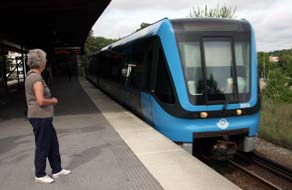 Our first day in Stockholm: it
poured with rain all night and this morning the waterlogged pitches and traffic
noise made the overcrowding even more miserable. And despite the extortionate
prices, facilities at Ängby Camping were the worst of the entire trip: showers
and toilets were cramped, old-fashioned and grubby and the limited number meant
inevitable queues; the kitchen was poorly equipped and limited wash-ups sinks
again meant queuing. With the weather still gloomily overcast, we set off for
the 800m walk to the Ängbyplan Metro station. Stockholm's Metro system, the
Tunnel-bana (T-bana) provides a fast and efficient means of public transport
around the city (see left); single tickets are expensive (like everything else in
Stockholm) costing 32kr but last for an hour covering both T-bana and buses
(Photo 2 - Stockholm's Metro, the Tunnel-bana). We
followed the journey into the centre on the map noting the pronunciation of
station names as they were announced, and amid the crowds got off at T-Centralen,
a bewildering station complex covering a vast area and with multiple exits. The
first challenge was identifying our location when we emerged feeling even more
disorientated Our first day in Stockholm: it
poured with rain all night and this morning the waterlogged pitches and traffic
noise made the overcrowding even more miserable. And despite the extortionate
prices, facilities at Ängby Camping were the worst of the entire trip: showers
and toilets were cramped, old-fashioned and grubby and the limited number meant
inevitable queues; the kitchen was poorly equipped and limited wash-ups sinks
again meant queuing. With the weather still gloomily overcast, we set off for
the 800m walk to the Ängbyplan Metro station. Stockholm's Metro system, the
Tunnel-bana (T-bana) provides a fast and efficient means of public transport
around the city (see left); single tickets are expensive (like everything else in
Stockholm) costing 32kr but last for an hour covering both T-bana and buses
(Photo 2 - Stockholm's Metro, the Tunnel-bana). We
followed the journey into the centre on the map noting the pronunciation of
station names as they were announced, and amid the crowds got off at T-Centralen,
a bewildering station complex covering a vast area and with multiple exits. The
first challenge was identifying our location when we emerged feeling even more
disorientated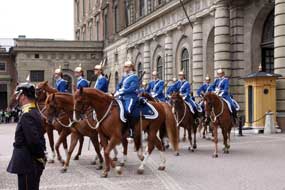 than normally on arrival at a new capital city. Crowds, traffic,
road works and absence of street names left us totally bemused. We struggled to
find a way through unidentified back streets to Drottning-gatan, a narrow and
pedestrianised street crowded with tourists and lined with the tackiest of tat
shops, thoroughly unattractive. We headed towards the Riksbron and parliament
building to emerge by the narrow channel of Norrström, part of Lake Mälaren,
which separates Riddarholmen, the large island now covered by the buildings of
Stockholm's Old Town, Gamla Stan than normally on arrival at a new capital city. Crowds, traffic,
road works and absence of street names left us totally bemused. We struggled to
find a way through unidentified back streets to Drottning-gatan, a narrow and
pedestrianised street crowded with tourists and lined with the tackiest of tat
shops, thoroughly unattractive. We headed towards the Riksbron and parliament
building to emerge by the narrow channel of Norrström, part of Lake Mälaren,
which separates Riddarholmen, the large island now covered by the buildings of
Stockholm's Old Town, Gamla Stan
Stockholm's history: Stockholm had
been founded here on the island of Riddarholmen in 1255 as a fortification to
secure the original city of Sigtuna from maritime attack. The settlement
developed through trade with other cities of the Hanseatic League, and German
merchants set up business here gaining Stockholm its predominant position over
Sigtuna which it soon eclipsed by the 14~15th centuries. Following the break-up
of the Kalmar Union and Gustav Vasa's capture of Stockholm and establishment of
an independent Swedish kingdom in 1523, royal power was established in the city
making it the capital of
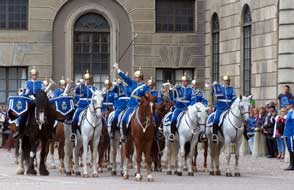 what would become one of Europe's major powers under
King Gustav II Adolfus in the 17th century. Military defeat by Imperial Russia
in the 18th century Great Northern Wars brought an end to Swedish territorial
expansion in Northern and Eastern Europe, and Stockholm developed politically
and culturally as capital of a smaller Swedish state. During the 19th century it
was still little more than a rural town, becoming overcrowded and lacking all the features of urban life
like piped water supply and drainage. Sweden's neutrality
during WW2 meant the city escaped the bomb damage suffered by other European
capitals, and the post-war Social-Democratic domination in Swedish politics
brought a sustained programme of modernisation. Here we stood by the water's
edge of Lake Mälaren which pervades every corner of the city, still bemused by
the inevitable crowds of tourists in mid-August. what would become one of Europe's major powers under
King Gustav II Adolfus in the 17th century. Military defeat by Imperial Russia
in the 18th century Great Northern Wars brought an end to Swedish territorial
expansion in Northern and Eastern Europe, and Stockholm developed politically
and culturally as capital of a smaller Swedish state. During the 19th century it
was still little more than a rural town, becoming overcrowded and lacking all the features of urban life
like piped water supply and drainage. Sweden's neutrality
during WW2 meant the city escaped the bomb damage suffered by other European
capitals, and the post-war Social-Democratic domination in Swedish politics
brought a sustained programme of modernisation. Here we stood by the water's
edge of Lake Mälaren which pervades every corner of the city, still bemused by
the inevitable crowds of tourists in mid-August.
Changing of the Guards at the Royal Palace:
we hurried across under the archway linking the parliament building's 2 wings,
following the crowds up the steps into the courtyard of Tessin the Younger's
Royal Palace; the Changing of the Guards which takes place daily at
12-15 was clearly a popular tourist attraction. Officious young soldiers in
their comic-opera dress uniforms were marshalling the crowds behind cordons
around the edge of the square, and we managed to find positions with something
of a view but with little idea of what was to happen. More of these most
unmilitary looking young soldiers pranced around, some brimming with
self-importance, others clearly feeling self-conscious in front of the crowds.
An announcement over the PA, partly in English, detailed the history of the
Swedish Life Guards formed by Gustav Vasa as a royal protection squad, although
the present generation of guards looked incapable of defending even a child's toy
fort! Eventually a troop of cavalry trotted around led by mounted musicians who
played a selection of musical comedy airs while other soldiers hidden by the
crowds marched around. It was all a bit twee, lacking much of the dignity of the
equivalent British spectacle, but the tourists loved it and the Japanese
photographed one another in front of it all as the horses trotted around
distributing horse dung with military precision
(Photo 3 - Changing the Guards at Stockholm's Royal Palace).
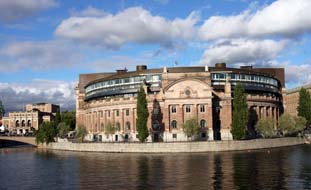 We extricated ourselves to get
back for the next parliamentary visit. We extricated ourselves to get
back for the next parliamentary visit.
 Visit
to the Riksdag (Swedish Parliament): Group 4
clearly has a very lucrative security contract with the Riksdag administration
since their guards on the entrance to the Parliament building were changed at
least 3 times while we queued for admission; it was first come, first served,
and the next 28 visitors joined the hour-long tour. Eventually we were admitted
and posses of Group 4 security staff subjected us to the usual emptying of
pockets rigmarole. The guide, speaking in fluent English, led us up to the
plenary chamber's hallway from where we could look down over the panorama of Lake Mälaren and Stockholm City Hall
(Photo 4 - Panorama over Lake Mälaren and Stockholm City Hall). Before taking us into the visitors' gallery she gave a background history of
Sweden's parliamentary system. Until constitutional changes in 1971, the Riksdag had
been bi-cameral with one chamber elected by popular ballot, the other by more
selective political groups. The 2 chambers met in the East Wing of the
parliamentary building built in 1905. With the change to unicameral system, a
new and larger chamber was needed: the oval-shaped West Wing formerly occupied
by the national bank was taken over and a new upper storey added in the 1970s to
create the oval-shaped modern plenary chamber where we now gathered. Visit
to the Riksdag (Swedish Parliament): Group 4
clearly has a very lucrative security contract with the Riksdag administration
since their guards on the entrance to the Parliament building were changed at
least 3 times while we queued for admission; it was first come, first served,
and the next 28 visitors joined the hour-long tour. Eventually we were admitted
and posses of Group 4 security staff subjected us to the usual emptying of
pockets rigmarole. The guide, speaking in fluent English, led us up to the
plenary chamber's hallway from where we could look down over the panorama of Lake Mälaren and Stockholm City Hall
(Photo 4 - Panorama over Lake Mälaren and Stockholm City Hall). Before taking us into the visitors' gallery she gave a background history of
Sweden's parliamentary system. Until constitutional changes in 1971, the Riksdag had
been bi-cameral with one chamber elected by popular ballot, the other by more
selective political groups. The 2 chambers met in the East Wing of the
parliamentary building built in 1905. With the change to unicameral system, a
new and larger chamber was needed: the oval-shaped West Wing formerly occupied
by the national bank was taken over and a new upper storey added in the 1970s to
create the oval-shaped modern plenary chamber where we now gathered.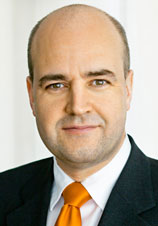
The Swedish Riksdag
has 349 members elected by proportional representation for a 4 year term from
the country's 29 constituencies which correspond with the counties. In the last
general election of 2010, 84% of the 7 million Swedes on the national electoral
role voted. With the constitutional threshold of 4% of votes cast to qualify for
party status and receive state funding, there are currently 8 political parties
in the Riksdag. To stand as an MP, candidates must be adopted by one of the
recognised parties. The present government is formed by a centre-right coalition
made up of the leading Moderate Party (107 seats), Liberal Party (24 seats),
Centre Party (23 seats) and Christian Democrats (19 seats) making a total of 173
seats, 2 short of an absolute majority. The Opposition is made up of the Social
Democratic Party (112 seats), Green Party (25 seats) and Left Party (19 seats),
a total of 156 seats. The balance of power however is held by a new party formed
in 2010, the Sweden Democrats, with 20 seats who entered Parliament on a ticket
of reducing immigration, an understandable thorny topical issue in Swedish
politics looking around Stockholm or any Swedish town or city today. The Prime
Minister is elected by MPs from
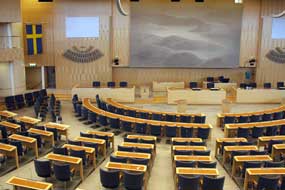 the majority party, the current PM (since 2006)
being Frederik Reinfeldt leader of the Moderate Party (see right). Parliament is chaired by
the Speaker, who is also elected by MPs from their number; the current office
holder is Per Westerberg. In October each year, the King, currently Carl XVI
Gustaf, as Head of State officially opens the new parliament, and the PM
announces the government's programme for the coming year. Much of the work of
preparing parliamentary business and refining bills is conducted by the 15 standing
committees. the majority party, the current PM (since 2006)
being Frederik Reinfeldt leader of the Moderate Party (see right). Parliament is chaired by
the Speaker, who is also elected by MPs from their number; the current office
holder is Per Westerberg. In October each year, the King, currently Carl XVI
Gustaf, as Head of State officially opens the new parliament, and the PM
announces the government's programme for the coming year. Much of the work of
preparing parliamentary business and refining bills is conducted by the 15 standing
committees.
From the visitors' gallery, we looked down into the oval parliamentary chamber
where MPs sit grouped not by political party but by constituency
(see left) (Photo 5 - Plenary chamber of the Swedish Parliament, the Riksdag). From there we
were led across the bridge link to the West Wing to see the twin chambers
previously used by the pre-1971 bi-cameral parliament and now used as meeting
rooms by the 2 largest parties. On the return walk to the security entrance, we
paused by the portraits of the leaders of the 4 Estates (Nobility, Clergy,
Burghers and Peasantry) who in 1809 had agreed to offer the Swedish throne to
Napoleon's Marshall, Jean-Baptiste Bernadotte who became King Karl XIV Johan,
founder of the Bernadotte dynasty, the current royal family. This had been
another educative parliamentary visit to supplement our list of European
parliaments visited during our travels, and to add further to our understanding
of our present host-country's society. What had impressed us most was the
unbelievable level of Swedish political participation (84% turnout in the 2010
general election) compared with UK's sad indifference towards its governance.
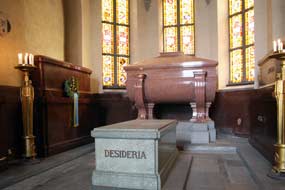
The island of Riddarholmen and the Riddarholms-kyrkan: we had
decided to devote our first day in the capital to the Gamla Stan (Old Town) area
of the city spread across the central islands of Stadsholmen, Helgeandsholmen
and Riddarholmen. Leaving the parliament we crossed the bridge firstly to the
neighbouring island of Riddarholmen to find the Riddarholms-kyrkan. This ancient
foundation, originally a Franciscan monastery until the 1525 Reformation, has
for centuries been the royal burial church for Swedish monarchs starting with
Magnus Ladulås in 1290 whose sarcophagus stood in the chancel. The church's
inner walls were lined with the coats of arms of the Swedish Seraphim
knightly order. Leading noble families had their sepulchral chapels around the
nave, but of greater interest were the royal dynastic burial chapels: the
Carolean monarchs, the huge sarcophagus of Gustav II Adolfus with smaller tombs
of his family
(Photo 6 - Sarcophagus of King Gustav II Adolfus), down in the crypt the tombs of Gustav III and his family, and in
a side chapel the large sarcophagus of Jean-Baptiste Bernadotte (Karl XIV Johan)
along with tombs of his family (see right). As we walked around, we struggled to recall the
historical significance of all those buried in this royal pantheon of
Swedish monarchs. Despite the still murkily overcast sky, Riddarholmen's outer
quay gave a panoramic view across the width of Lake Mälaren to Stockholm's
city hall, its slender tower topped by the Swedish crest of 3 gilded crowns.
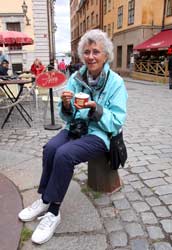 Stockholm's Gamla Stan (Old Town): re-crossing to Stadsholmen, we walked up through the
narrow streets of the Old Town to Stockholm's cathedral, Storkyrkan set on the
highest point of the island and crammed in among other old buildings. Built
in 1279, it is now the royal church where traditionally Swedish monarchs have
been crowned and married. The narrow street of Trångsund was lined with shops
selling the tackiest of tourist ephemera and thronged with hoards of mindless
tourists among whom mingled some very suspicious-looking characters suggesting
this was prime territory for pickpockets. This led to the more pleasant sloping
open space of Stortorget, one side of which was lined with the Baroque building
of the Nobel Museum, the others with crowded street cafés
(Photo 7 - Stortorget in Gamla Stan). This square had been
the scene of the Danish King Christian II's massacre of Swedish nobility in
1520, known as the 'Stockholm Bloodbath', before he himself was booted out along
with the rest of the Danes by Gustav Vasa's successful Swedish coup in 1623. We
continued along Trångsund, eyeing uneasily the dodgy characters hovering among
the crowds of tourists, to reach the Tyska kyrkan. Built originally for
Stockholm's medieval German merchants, the church had received the usual
extravaganza of Baroque embellishment in the 18th century. On to Järntorget we paused for ice creams
(see left),
before walking down to the quay at Slussen to investigate
ferries across Lake Mälaren to Djurgården for tomorrow. Stockholm's Gamla Stan (Old Town): re-crossing to Stadsholmen, we walked up through the
narrow streets of the Old Town to Stockholm's cathedral, Storkyrkan set on the
highest point of the island and crammed in among other old buildings. Built
in 1279, it is now the royal church where traditionally Swedish monarchs have
been crowned and married. The narrow street of Trångsund was lined with shops
selling the tackiest of tourist ephemera and thronged with hoards of mindless
tourists among whom mingled some very suspicious-looking characters suggesting
this was prime territory for pickpockets. This led to the more pleasant sloping
open space of Stortorget, one side of which was lined with the Baroque building
of the Nobel Museum, the others with crowded street cafés
(Photo 7 - Stortorget in Gamla Stan). This square had been
the scene of the Danish King Christian II's massacre of Swedish nobility in
1520, known as the 'Stockholm Bloodbath', before he himself was booted out along
with the rest of the Danes by Gustav Vasa's successful Swedish coup in 1623. We
continued along Trångsund, eyeing uneasily the dodgy characters hovering among
the crowds of tourists, to reach the Tyska kyrkan. Built originally for
Stockholm's medieval German merchants, the church had received the usual
extravaganza of Baroque embellishment in the 18th century. On to Järntorget we paused for ice creams
(see left),
before walking down to the quay at Slussen to investigate
ferries across Lake Mälaren to Djurgården for tomorrow.
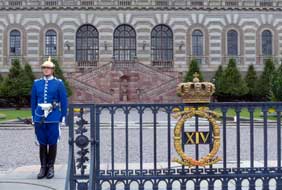 With the sky at last beginning to brighten, we walked along the waterfront past
moored ferries and over-priced quay-side restaurants. With glances up at the
buildings of Gamla Stan crowded onto Stadsholmen's crest, we continued along
towards Slottsbacken which was lined with Tessin's featureless four-square
Royal Palace with Storkyrkan at the crest of the hill. The 2 arms of the Royal
Palace's east wing enclosing gardens stretched down towards the waters of Lake Mälaren.
Tessin had designed his Palace in simple, uniform style to replace the former
Tre Kronor castle which had burnt down during Karl XII's reign at the beginning
of the 18th century. At the top of the steps at the level of the palace gardens,
a blue-uniformed young soldier stood guarding one of the royal flower pots;
after performing a couple of comical prances for the benefit of his sergeant who
came on a tour of inspection, he settled back into his sentry box (see right). At the corner
of the palace, a gushing fountain poured down into a basin looking for all the
world as if someone had just flushed one of the royal loos. The sun at last
broke through lighting the views along towards Gamla Stan
(Photo 8 - Looking towards Gamla Stan from the Royal Palace)
and over the bridge to the Opera House across the
water (Photo 9 - City panorama across Norrström and Strömbron). We crossed to the lawned gardens of the Riksdaghuset, its east façade now
in deep shade, but from under the trees we were able to photograph the now
well-lit Royal Palace (Photo 10 - Royal Palace built by Tessin the Younger in 1754). With the sky at last beginning to brighten, we walked along the waterfront past
moored ferries and over-priced quay-side restaurants. With glances up at the
buildings of Gamla Stan crowded onto Stadsholmen's crest, we continued along
towards Slottsbacken which was lined with Tessin's featureless four-square
Royal Palace with Storkyrkan at the crest of the hill. The 2 arms of the Royal
Palace's east wing enclosing gardens stretched down towards the waters of Lake Mälaren.
Tessin had designed his Palace in simple, uniform style to replace the former
Tre Kronor castle which had burnt down during Karl XII's reign at the beginning
of the 18th century. At the top of the steps at the level of the palace gardens,
a blue-uniformed young soldier stood guarding one of the royal flower pots;
after performing a couple of comical prances for the benefit of his sergeant who
came on a tour of inspection, he settled back into his sentry box (see right). At the corner
of the palace, a gushing fountain poured down into a basin looking for all the
world as if someone had just flushed one of the royal loos. The sun at last
broke through lighting the views along towards Gamla Stan
(Photo 8 - Looking towards Gamla Stan from the Royal Palace)
and over the bridge to the Opera House across the
water (Photo 9 - City panorama across Norrström and Strömbron). We crossed to the lawned gardens of the Riksdaghuset, its east façade now
in deep shade, but from under the trees we were able to photograph the now
well-lit Royal Palace (Photo 10 - Royal Palace built by Tessin the Younger in 1754).
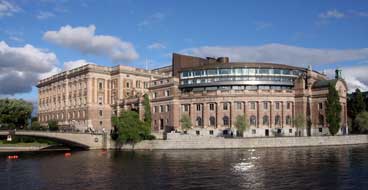 Crossing the bridge to Gustav
Adolfs Torg where fisherman lined the water's edge casting their lines for
salmon in the murky waters flowing along the Norrström channel, there were
splendid views of the Riksdag's East Wing now well-lit by the late afternoon
sun (Photo 11 - East wing of the Riksdag). Back at our day's starting point at Riksbron we were able to photograph the
parliament's West Wing curving façade with the modern parliamentary chamber's
upper storey extension visited earlier. Crossing the Vasabron, there was a
perfect panorama across Lake Mälaren of the entire Riksdag and government
offices lit by the western sun (see left) (Photo 12 - Panorama of the Swedish Parliament Buildings). On the southern side of the bridge we passed the
magnificent 17th century Baroque building of the Riddarhuset in whose Great Hall
the Nobility Estate had met to govern the country before the 1865 constitutional reforms abolished the 4 Estates in favour of a bi-cameral parliament on European
lines (Photo 13 - 17th century Baroque Riddarhuset). Negotiating a way along the pedestrian-unfriendly Centralbron, we
eventually reached the uncharacteristically grubby Gamla Stan T-bana station, to catch our #18 Metro on the Hässelby Strand line back out to the campsite.
Our first day in Stockholm had been a rewarding one with our visit to the
Parliament, but despite the city's attractive watery environment and
grandiose buildings, Gamla Stan had a distinctly unsafe feel with an
ever-present sense of pickpockets loitering among the crowds of tourists;
perhaps it's a sign of the times we now live in. Crossing the bridge to Gustav
Adolfs Torg where fisherman lined the water's edge casting their lines for
salmon in the murky waters flowing along the Norrström channel, there were
splendid views of the Riksdag's East Wing now well-lit by the late afternoon
sun (Photo 11 - East wing of the Riksdag). Back at our day's starting point at Riksbron we were able to photograph the
parliament's West Wing curving façade with the modern parliamentary chamber's
upper storey extension visited earlier. Crossing the Vasabron, there was a
perfect panorama across Lake Mälaren of the entire Riksdag and government
offices lit by the western sun (see left) (Photo 12 - Panorama of the Swedish Parliament Buildings). On the southern side of the bridge we passed the
magnificent 17th century Baroque building of the Riddarhuset in whose Great Hall
the Nobility Estate had met to govern the country before the 1865 constitutional reforms abolished the 4 Estates in favour of a bi-cameral parliament on European
lines (Photo 13 - 17th century Baroque Riddarhuset). Negotiating a way along the pedestrian-unfriendly Centralbron, we
eventually reached the uncharacteristically grubby Gamla Stan T-bana station, to catch our #18 Metro on the Hässelby Strand line back out to the campsite.
Our first day in Stockholm had been a rewarding one with our visit to the
Parliament, but despite the city's attractive watery environment and
grandiose buildings, Gamla Stan had a distinctly unsafe feel with an
ever-present sense of pickpockets loitering among the crowds of tourists;
perhaps it's a sign of the times we now live in.
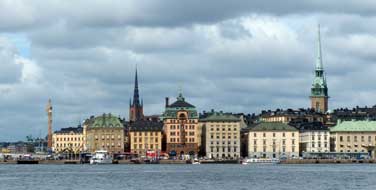 Day 2 of our visit to Stockholm - ferry across the harbour to Djurgården to
visit the Vasa Museum: with the sky clearer this morning and
sun shining through the trees, we made our way back over to the Ängbyplan Metro
station. The train was busier on a Saturday morning and we continued 2 further
stops beyond T-Centralen down to Slussen. Emerging from the station, we crossed
the bridge to the southern end of Gamla Stan, glancing up to the wedge of old
buildings and church spires covering Stadsholmen. Our plan was to spend today on
the island of Djurgården, crossing by ferry from Slussen to visit the Museum
devoted to the preserved 17th century royal warship, the Vasa. On
reaching the ferry terminal, it was clear from the long queues that many others,
both tourists and locals, were also heading across to Djurgården most likely to
visit the outdoor museum of Skansen or the Tivoli fairground at Gröna Lunds; there
would be a long wait for the ferry. Pensioners' tickets were available reduced
from 45kr to 30kr, a good price for such a popular journey, and in fact the
queue moved quickly as boat followed boat across the harbour. We were soon
aboard and stood at the forward end for photos of the magnificent panorama of
Gamla Stan as the ferry chugged across the
waters of Lake Mälaren (see right) (Photo 14 - Panorama of Gamla Stan from Djurgården ferry). We did not realise it at the time, but the ferry passed
close to the spot where the warship Vasa had sunk in 1628 just off the
island of Beckholmen. As the ferry drew into the Tivoli dock on Djurgården, we
could hear the screams of fairground visitors being hurtled around on the
roller coasters towering overhead. We followed the quay around and ahead could
see the curious outline of the museum building specially constructed on the site
of a former naval dockyard to house the preserved wooden warship Vasa
with mast-heads seemingly projecting through the roof. Day 2 of our visit to Stockholm - ferry across the harbour to Djurgården to
visit the Vasa Museum: with the sky clearer this morning and
sun shining through the trees, we made our way back over to the Ängbyplan Metro
station. The train was busier on a Saturday morning and we continued 2 further
stops beyond T-Centralen down to Slussen. Emerging from the station, we crossed
the bridge to the southern end of Gamla Stan, glancing up to the wedge of old
buildings and church spires covering Stadsholmen. Our plan was to spend today on
the island of Djurgården, crossing by ferry from Slussen to visit the Museum
devoted to the preserved 17th century royal warship, the Vasa. On
reaching the ferry terminal, it was clear from the long queues that many others,
both tourists and locals, were also heading across to Djurgården most likely to
visit the outdoor museum of Skansen or the Tivoli fairground at Gröna Lunds; there
would be a long wait for the ferry. Pensioners' tickets were available reduced
from 45kr to 30kr, a good price for such a popular journey, and in fact the
queue moved quickly as boat followed boat across the harbour. We were soon
aboard and stood at the forward end for photos of the magnificent panorama of
Gamla Stan as the ferry chugged across the
waters of Lake Mälaren (see right) (Photo 14 - Panorama of Gamla Stan from Djurgården ferry). We did not realise it at the time, but the ferry passed
close to the spot where the warship Vasa had sunk in 1628 just off the
island of Beckholmen. As the ferry drew into the Tivoli dock on Djurgården, we
could hear the screams of fairground visitors being hurtled around on the
roller coasters towering overhead. We followed the quay around and ahead could
see the curious outline of the museum building specially constructed on the site
of a former naval dockyard to house the preserved wooden warship Vasa
with mast-heads seemingly projecting through the roof.
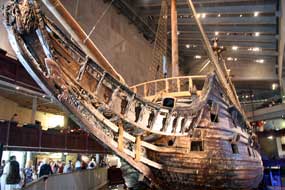 The 1628 sinking of the Vasa
in Stockholm harbour: The Vasa had been constructed on the
orders of King Gustav II Adolfus who, in the arms race with Sweden's arch-enemy
the Danes, wanted the most powerful warship afloat with 72 heavy guns. Vasa
was therefore built to royal specification as the Royal Ship, Sweden's foremost
naval vessel of the day, in the Skeppsgården navy yards by the Dutch
shipwright Henryk Hybertson. 1,000 oak trees were selected for timber for the
huge ship's construction which took 3 years. In early August 1628, the new ship
was ready for her maiden voyage, moored just below the Royal Castle in the
centre of Stockholm, and loaded with ballast, guns and ammunition. Gustav II
Adolfus was as usual away in Prussia fighting with the Poles, and was impatient
to have his new warship join his forces. On Sunday 10 August 1628, crowds lined
the quays to witness the sailing of the Swedish navy's prestigious new warship.
On board were just over 100 of the ship's normal full crew of 300 along with
members of their families who were given permission to join the first part of the
maiden voyage down the archipelago. The occasion of great pomp and ceremony was
described with vivid accuracy by the Danish ambassador in a letter to his
government describing Sweden's new mightily armed warship. The 1628 sinking of the Vasa
in Stockholm harbour: The Vasa had been constructed on the
orders of King Gustav II Adolfus who, in the arms race with Sweden's arch-enemy
the Danes, wanted the most powerful warship afloat with 72 heavy guns. Vasa
was therefore built to royal specification as the Royal Ship, Sweden's foremost
naval vessel of the day, in the Skeppsgården navy yards by the Dutch
shipwright Henryk Hybertson. 1,000 oak trees were selected for timber for the
huge ship's construction which took 3 years. In early August 1628, the new ship
was ready for her maiden voyage, moored just below the Royal Castle in the
centre of Stockholm, and loaded with ballast, guns and ammunition. Gustav II
Adolfus was as usual away in Prussia fighting with the Poles, and was impatient
to have his new warship join his forces. On Sunday 10 August 1628, crowds lined
the quays to witness the sailing of the Swedish navy's prestigious new warship.
On board were just over 100 of the ship's normal full crew of 300 along with
members of their families who were given permission to join the first part of the
maiden voyage down the archipelago. The occasion of great pomp and ceremony was
described with vivid accuracy by the Danish ambassador in a letter to his
government describing Sweden's new mightily armed warship.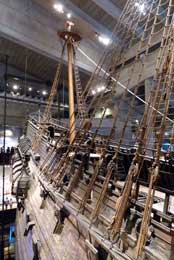
Stability tests were conducted
with 30 men running back and forth across the deck while the ship was moored at
the quay, but after 3 runs the test was stopped because the ship listed badly;
suspicion was already rife about Vasa's stability. The captain however
ordered the ship to be kedged out into the main channel; 4 of the ship's sails
were set, the guns fired, and Vasa moved forward across the harbour under
her own power. But she had not advanced more than 1,300m when a sudden gust of
wind from the SW caught her; she keeled over with water rushing into her still
open gun ports, and the mighty warship slowly sank to the bottom of the harbour
in 32m of water, drowning around 50 of those on board. News of the disaster
reached the King 2 weeks later; he wrote to the Council of the Realm that
'imprudence or negligence must have been the cause', and demanded that the guilty
parties must be punished. It was a total embarrassment for all from the King
downwards; he had said that 'second to God, the welfare of the Kingdom depends
on its Navy', and the Vasa with its mighty armaments was built to his own
specifications. Sweden had already lost several warships in the period 1624~28
both to storms and to enemy action and the Vasa was essential to maintain
Sweden's naval supremacy in the Baltic.
Two theories accounting for the
loss were examined by the court of enquiry: 1) the weight of the improperly
secured guns rolling back caused the listing 2) the
crew were drunk and failed in their duties. But the Captain, Dutch-born Söfring
Hansson, swore that the guns had been secured, and he
blamed its design and construction for ship's instability. The crew also were questioned and swore that
the ballast was loaded; it was Sunday and they had been to church having had
nothing to drink. They also asserted that the ship was unstable: the keel was
too small in relation to the size, height and top-heavy weight of the vessel.
The original ship-builder had died the previous year, but his successor Hein Jakobsson and the shipyard master Arent de Groot, both experienced Dutch
shipwrights, insisted that work had been carried out to the specifications and
dimensions commissioned by the King himself. Whose fault was it then? demanded
the interrogator; only God knows, answered de Groot. Both the King and God were
considered infallible, and no guilty party was ever identified or punished.
Gustav II Adolfus was killed 4 years later in 1632 at the Battle of Lützen and
the matter of the cause of Vasa's sinking was quietly allowed to be
forgotten.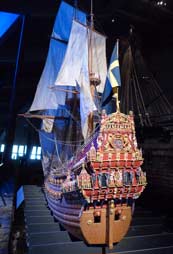
In modern retrospect, who was to
blame? partly the Admiral for allowing the ship to sail after the uncertain
stability tests, but he was facing Gustav's impatience to have his new warship
delivered; partly the King who had insisted on this specification of size and
heavy armaments; partly the ship-builder, but he already had a sound record of
building successful warships and the Vasa was well-constructed and
differed from other ships of the day only in size and heavy armaments. 17th
century ships were constructed not to drawings but empirically from the
shipwright's experience. The issue was that the Vasa was conceived as
simply too big and too heavily armed, and therefore too top heavy for the
designs of the day; she was a maritime disaster just waiting to happen.
Immediate attempts were made to
salvage the Vasa but these failed. In the 1660s her heavy cannons were
recovered; they each weighed over a ton and using only the air supply in a
primitive diving bell, hooks were attached to each cannon and 50 were lifted. It
was a remarkable achievement. The wreck of the Vasa was abandoned and
remained forgotten in 32m of mud and water, but in 1956 an experienced salvage
engineer, Anders Franzén located the ship. Divers working in the murky depths
secured steel cables under the wreck and in 1961, she was lifted by a salvaging
company. The Vasa re-appeared on the surface of Stockholm harbour 333
years after her sinking with the world's press and TV to witness this incredible
event. The ship's timbers, which had been protected against rot by the Baltic's
low salinity, were treated with polyethylene glycol and the jigsaw puzzle of
recovered pieces reassembled, so that 95% of the preserved wreck is original.
After the wreck was raised, diving operations continued investigating the seabed
around the wreck site, and many of the Vasa's carved wooden sculptures
were also recovered along with her wooden gun carriages from which the cannon
had been lifted. The conserved warship is now displayed in a specially designed
museum so that the Vasa can now be seen in her full glory (Photo 15 -
Specially-built museum for the warship Vasa); with her full
masts, she would have towered over 50m (164 feet) high. Visit the
Vasa Museum web site
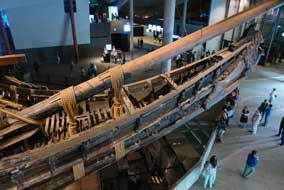 Our visit to Vasa Museum: we queued and paid what seemed an
expensive admission of 130kr each, and entered the dimly lit hall: there ahead
stood the Vasa, an utterly staggering sight
(Photo 16 - the conserved warship Vasa). Having viewed the film
detailing the sunken warship's discovery and recovery, we joined one of the
English language guided tours to stand alongside the Vasa's open cannon
ports as the guide gave a detailed description of the background to 17th century
naval warfare, the King's insistence on the warship's scale and armaments, the
events of 10 August 1628 leading up to the sinking, the vessel's recovery and
conservation, and a detailed examination of the causes of the loss. By
coincidence today happened also to be 10 August, 385 years to the day since the Vasa's
fateful sinking. We now had a full 4 hours for close examination of the full
scale of the conserved vessel over its full height at 6 levels, from its keel
below the shallow water line, the 2 cannon decks, higher levels giving clear
views of the Vasa's magnificently decorative wooden sculptures, right up
to a gallery overlooking the full length of the upper deck, masts, rigging and
narrow stern castle (Photo 17 - Vasa's deck, masts, rigging and stern-castle). On 4 of the floors, there were also accompanying
exhibitions with detailed multi-lingual commentaries. Our visit to Vasa Museum: we queued and paid what seemed an
expensive admission of 130kr each, and entered the dimly lit hall: there ahead
stood the Vasa, an utterly staggering sight
(Photo 16 - the conserved warship Vasa). Having viewed the film
detailing the sunken warship's discovery and recovery, we joined one of the
English language guided tours to stand alongside the Vasa's open cannon
ports as the guide gave a detailed description of the background to 17th century
naval warfare, the King's insistence on the warship's scale and armaments, the
events of 10 August 1628 leading up to the sinking, the vessel's recovery and
conservation, and a detailed examination of the causes of the loss. By
coincidence today happened also to be 10 August, 385 years to the day since the Vasa's
fateful sinking. We now had a full 4 hours for close examination of the full
scale of the conserved vessel over its full height at 6 levels, from its keel
below the shallow water line, the 2 cannon decks, higher levels giving clear
views of the Vasa's magnificently decorative wooden sculptures, right up
to a gallery overlooking the full length of the upper deck, masts, rigging and
narrow stern castle (Photo 17 - Vasa's deck, masts, rigging and stern-castle). On 4 of the floors, there were also accompanying
exhibitions with detailed multi-lingual commentaries.
Starting below the waterline, we
were overwhelmed by the immensity of the vessel towering above us, astonished
that 17th century ships of this size had virtually no visible keel and were
almost flat-bottomed. At the ground-floor level, there was further impression of
the Vasa's scale and the level of decorative sculptures which covered the
bows and stern. Originally gilded and painted in
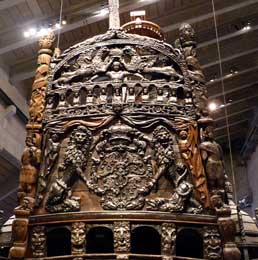 bright colours, as well as
being a formidable fighting machine the ship would also have presented a potent
propaganda weapon symbolising the power and glory of Gustav II Adolfus' Swedish
Kingdom. The next 2 levels gave clear views of the 2 decks of cannon ports
which, when opened showed their lions' heads carved decorations, a terrifying
sight to confront enemy vessels (Photo 18 - Vasa's lion head decorated cannon ports). Information panels gave details of the ship's
features and technical aspects of its working. At this level also we could
examine closely the elaborate wooden sculptures lining the bowsprit in the form
of lines of Roman emperors, culminating in huge rampant lions forming the prow
figurehead (Photo 19 - Carved lions figurehead decorating Vasa's prow). Around at the stern, the huge rear panel of the stern castle was one mass
of beautifully preserved wooden sculptures, the centrepiece of which was a
pair of rampant lions embracing the Vasa crest (see left) (Photo 20 - Carved crest decorating Vasa's stern castle). The galleries enabled close
inspection of this formidable artwork's detailed intricacies, and gave the full
impression of the unbelievable height of the masts; only the lower sections had
been preserved making up just one third of the vessel's original full 50m
height. From the top gallery, we could look down the full length of the ship,
revealing just how narrow the stern had been, one of the factors which for a
vessel of this scale and weight of armaments (72 cannon each weighting one ton)
accounted for the Vasa being so top-heavy and vulnerable to keeling over. bright colours, as well as
being a formidable fighting machine the ship would also have presented a potent
propaganda weapon symbolising the power and glory of Gustav II Adolfus' Swedish
Kingdom. The next 2 levels gave clear views of the 2 decks of cannon ports
which, when opened showed their lions' heads carved decorations, a terrifying
sight to confront enemy vessels (Photo 18 - Vasa's lion head decorated cannon ports). Information panels gave details of the ship's
features and technical aspects of its working. At this level also we could
examine closely the elaborate wooden sculptures lining the bowsprit in the form
of lines of Roman emperors, culminating in huge rampant lions forming the prow
figurehead (Photo 19 - Carved lions figurehead decorating Vasa's prow). Around at the stern, the huge rear panel of the stern castle was one mass
of beautifully preserved wooden sculptures, the centrepiece of which was a
pair of rampant lions embracing the Vasa crest (see left) (Photo 20 - Carved crest decorating Vasa's stern castle). The galleries enabled close
inspection of this formidable artwork's detailed intricacies, and gave the full
impression of the unbelievable height of the masts; only the lower sections had
been preserved making up just one third of the vessel's original full 50m
height. From the top gallery, we could look down the full length of the ship,
revealing just how narrow the stern had been, one of the factors which for a
vessel of this scale and weight of armaments (72 cannon each weighting one ton)
accounted for the Vasa being so top-heavy and vulnerable to keeling over.
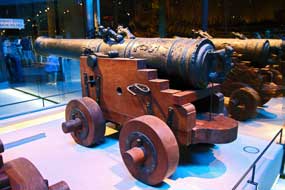 The accompanying exhibitions added
further to visitors' understanding of how such a prestigious vessel's artistic
adornments made the ship as much a propaganda weapon as military, promoting the
image of Gustav II Adolfus as the wise, ruthless but forgiving ruler of the
Kingdom. The displays explained how a large 17th century sailing vessel like the Vasa
would have been rigged, sailed and steered, and included one of her conserved
sails found folded in a lower hold sail locker; despite being one of the
smallest top fore-sails, it still covered a vast area of wall setting in context
just how big the main sails would have been. Details of the Vasa's
armaments showed that the objective of 17th century naval battles was not so
much to sink enemy vessels but disable and capture them or their cannons for
your own use; 3 of the Vasa's conserved original bronze cannon were
displayed each weighing one ton and emblazoned with the royal coat of arms (see
right). The
displays explained the stages of the Vasa's construction in the Skeppsgården
ship-yards, the location of her sinking (which we had passed earlier on the
ferry across the harbour), the discovery of the wreck site, her salvaging and
recovery and all the scientific processes in conserving and reconstructing her
timbers, and finally (and most movingly) the skeletal remains of 10 of those who
drowned at the Vasa's sinking with conjectured background on their lives
and appearance. Despite the seemingly expensive admission charge, we had spent
an engaging 5 hours in the Vasa Museum; the conserved ship itself displayed in
her full glory, with the galleries enabling such intimate viewing, together with
the excellently presented detailed exhibitions, made it one of the finest
museums we had seen in our travels, an indisputable 'must see' for anyone
visiting Stockholm. The accompanying exhibitions added
further to visitors' understanding of how such a prestigious vessel's artistic
adornments made the ship as much a propaganda weapon as military, promoting the
image of Gustav II Adolfus as the wise, ruthless but forgiving ruler of the
Kingdom. The displays explained how a large 17th century sailing vessel like the Vasa
would have been rigged, sailed and steered, and included one of her conserved
sails found folded in a lower hold sail locker; despite being one of the
smallest top fore-sails, it still covered a vast area of wall setting in context
just how big the main sails would have been. Details of the Vasa's
armaments showed that the objective of 17th century naval battles was not so
much to sink enemy vessels but disable and capture them or their cannons for
your own use; 3 of the Vasa's conserved original bronze cannon were
displayed each weighing one ton and emblazoned with the royal coat of arms (see
right). The
displays explained the stages of the Vasa's construction in the Skeppsgården
ship-yards, the location of her sinking (which we had passed earlier on the
ferry across the harbour), the discovery of the wreck site, her salvaging and
recovery and all the scientific processes in conserving and reconstructing her
timbers, and finally (and most movingly) the skeletal remains of 10 of those who
drowned at the Vasa's sinking with conjectured background on their lives
and appearance. Despite the seemingly expensive admission charge, we had spent
an engaging 5 hours in the Vasa Museum; the conserved ship itself displayed in
her full glory, with the galleries enabling such intimate viewing, together with
the excellently presented detailed exhibitions, made it one of the finest
museums we had seen in our travels, an indisputable 'must see' for anyone
visiting Stockholm.
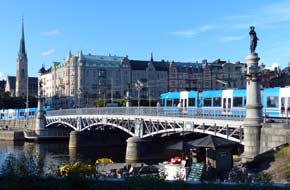 Memorial to the 1994 sinking of
M/S Estonia: we emerged into the late afternoon sunlight and
walked across the quayside gardens to see the memorial to the 852 who lost their
lives in a more recent maritime disaster, the sinking of the ferry Estonia
in 1994 sailing across the Baltic from Tallinn to Stockholm. The memorial takes
the form of a triangular walled enclosure inscribed with the names of those
killed (Photo 21 - Memorial to the 852 victims of 1994 Estonia sinking). In 2011 we had visited the memorial set up on the north coast on the
Estonian island of Hiiumaa looking out across the Baltic to where the Estonia
had sunk (see our 2011 log).
We walked around the waterfront looking across to the distant rides of the
Tivoli fairground (Photo 22 - Djurgården Tivoli Fairground rides from across the harbour) and photographed the gloriously palatial building of the Nordiska Museum, reaching the Djurgårdsbron with the western sun streaming
down Lake Mälaren as we crossed the bridge (Photo 23 - Stockholm trams crossing the Djurgårdsbron bridge). Trams from Djurgården island curved
round to run along the waterfront towards the centre, and we were able to catch
one right into the heart of the modern city at Sergelstorg,
stopping right outside T-Centralen for our Metro back out to the campsite. Memorial to the 1994 sinking of
M/S Estonia: we emerged into the late afternoon sunlight and
walked across the quayside gardens to see the memorial to the 852 who lost their
lives in a more recent maritime disaster, the sinking of the ferry Estonia
in 1994 sailing across the Baltic from Tallinn to Stockholm. The memorial takes
the form of a triangular walled enclosure inscribed with the names of those
killed (Photo 21 - Memorial to the 852 victims of 1994 Estonia sinking). In 2011 we had visited the memorial set up on the north coast on the
Estonian island of Hiiumaa looking out across the Baltic to where the Estonia
had sunk (see our 2011 log).
We walked around the waterfront looking across to the distant rides of the
Tivoli fairground (Photo 22 - Djurgården Tivoli Fairground rides from across the harbour) and photographed the gloriously palatial building of the Nordiska Museum, reaching the Djurgårdsbron with the western sun streaming
down Lake Mälaren as we crossed the bridge (Photo 23 - Stockholm trams crossing the Djurgårdsbron bridge). Trams from Djurgården island curved
round to run along the waterfront towards the centre, and we were able to catch
one right into the heart of the modern city at Sergelstorg,
stopping right outside T-Centralen for our Metro back out to the campsite.
We had enjoyed a memorable couple
of days in Stockholm and by being ultra-selective in our visits, we had managed
to cherry-pick what had for us been the best features, avoiding the startlingly
over-expensive admission charges of many places. We were now looking forward
tomorrow to escaping from the sordidly over-crowded Ängby Camping, hoping to
find more acceptable campsites away from the capital city.
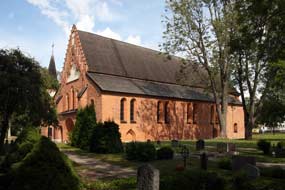 Sigtuna, Sweden's oldest
surviving town dating from Viking times: our 3 nights' rent cost
945kr, an amount which would normally buy us at least 4 nights' camping, but the sun was
bright to cheer our departure; we paid in silence but the reckoning was still to
come when we set in train our complaints to the fire authorities and place
the kiss-of-death on this dreadful place in our campsites review. Today we were
heading back north to Uppsala but on the way planned to call at Sigtuna,
Sweden's oldest borough dating back to Viking times. The satnav guided us
through a circuitous labyrinth of motorways Sigtuna, Sweden's oldest
surviving town dating from Viking times: our 3 nights' rent cost
945kr, an amount which would normally buy us at least 4 nights' camping, but the sun was
bright to cheer our departure; we paid in silence but the reckoning was still to
come when we set in train our complaints to the fire authorities and place
the kiss-of-death on this dreadful place in our campsites review. Today we were
heading back north to Uppsala but on the way planned to call at Sigtuna,
Sweden's oldest borough dating back to Viking times. The satnav guided us
through a circuitous labyrinth of motorways
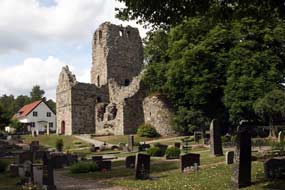 eventually leading to the E4
northwards and we joined the intolerantly aggressive traffic. Continuing north,
we turned off into the centre of the little town of Sigtuna. Although today a
small and unassuming town of 8,000 inhabitants, Sigtuna played an important part
in Sweden's early history and lays claims to being Sweden's oldest town. Founded by
King Eric in 980 AD on the shores of a
northern arm of Lake Mälaren, Sigtuna grew in significance as a royal trading
centre to become in the 11th century Sweden's most important town,
eclipsing Stockholm which at that time was still an obscure village. Such an
important royal domain was Sigtuna that Sweden's first coins were minted here
around 1000 AD. In 1230 the Dominican Order founded a monastery here which
played a leading role in Sweden's early medieval ecclesiastical history
producing many archbishops. But by 1300 Sigtuna was overtaken in significance by
fast developing Stockholm, while Sigtuna remained a small town. Despite a
devastating fire in late medieval times, the main church survived and the town
grew again around its original street plan. Its main street Storgatan still
follows its original route, claimed as Sweden's oldest street now under the line
of the modern street, lined with picturesque wooden shops and a regular summer
visitor attraction. eventually leading to the E4
northwards and we joined the intolerantly aggressive traffic. Continuing north,
we turned off into the centre of the little town of Sigtuna. Although today a
small and unassuming town of 8,000 inhabitants, Sigtuna played an important part
in Sweden's early history and lays claims to being Sweden's oldest town. Founded by
King Eric in 980 AD on the shores of a
northern arm of Lake Mälaren, Sigtuna grew in significance as a royal trading
centre to become in the 11th century Sweden's most important town,
eclipsing Stockholm which at that time was still an obscure village. Such an
important royal domain was Sigtuna that Sweden's first coins were minted here
around 1000 AD. In 1230 the Dominican Order founded a monastery here which
played a leading role in Sweden's early medieval ecclesiastical history
producing many archbishops. But by 1300 Sigtuna was overtaken in significance by
fast developing Stockholm, while Sigtuna remained a small town. Despite a
devastating fire in late medieval times, the main church survived and the town
grew again around its original street plan. Its main street Storgatan still
follows its original route, claimed as Sweden's oldest street now under the line
of the modern street, lined with picturesque wooden shops and a regular summer
visitor attraction.
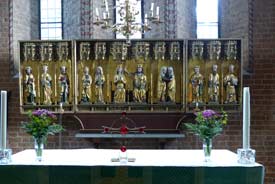 We walked along Storgatan and
found the TIC housed in a former 18th century inn, the Dragon, where the
girl provided us with an informative guide leaflet, highlighting for us the
historical sites and rune stones around the town. As an indication of Sigtuna's
10~11th century wealth and importance, some 150 rune stones have been found in
the area usually set up as memorials alongside ancient roads. Several of these
are scattered around the town's central area, some even in modern gardens. We
set off to walk the circuit. Just off the central square the tiny 18th century Rådhus, said to be Sweden's smallest town hall, was in process of re-roofing and
covered with scaffolding. Just beyond, up Olofsgatan we found the ruins of St
Olof's church founded in the 12~13th centuries, with its sturdily thick stone
walls and short stubby nave, still surrounded by a modern graveyard (see above
left) (Photo 24 - Ruins of 12~13th century St Olof's Church at Sigtuna). At the 1530
Reformation, Gustav Vasa ordered closure of all the country's monasteries and as
a result the Dominican priory was demolished and its church became the
Protestant parish church of St Mary. As a result, the town's We walked along Storgatan and
found the TIC housed in a former 18th century inn, the Dragon, where the
girl provided us with an informative guide leaflet, highlighting for us the
historical sites and rune stones around the town. As an indication of Sigtuna's
10~11th century wealth and importance, some 150 rune stones have been found in
the area usually set up as memorials alongside ancient roads. Several of these
are scattered around the town's central area, some even in modern gardens. We
set off to walk the circuit. Just off the central square the tiny 18th century Rådhus, said to be Sweden's smallest town hall, was in process of re-roofing and
covered with scaffolding. Just beyond, up Olofsgatan we found the ruins of St
Olof's church founded in the 12~13th centuries, with its sturdily thick stone
walls and short stubby nave, still surrounded by a modern graveyard (see above
left) (Photo 24 - Ruins of 12~13th century St Olof's Church at Sigtuna). At the 1530
Reformation, Gustav Vasa ordered closure of all the country's monasteries and as
a result the Dominican priory was demolished and its church became the
Protestant parish church of St Mary. As a result, the town's
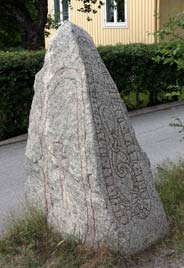 other churches
including St Olof's fell into ruins. Across the lane the Mariakyrkan stood in
its own graveyard, built of red brick in the 13th century to serve the Dominican
monastery and post-Reformation to become the parish church, a role it still
fulfils, its appearance now much as it was 700 years ago (see above right). A 15th century carved
wooden reredos stood behind the altar with a parade of saints either side of
Christ and Mary Queen of Heaven (see right). It was a truly beautiful church with 15th
century murals lining the vaulting of the north nave. Outside in the graveyard,
an 11th century runestone memorial stood alongside a beautifully recreated herb
garden recalling the former monastery. other churches
including St Olof's fell into ruins. Across the lane the Mariakyrkan stood in
its own graveyard, built of red brick in the 13th century to serve the Dominican
monastery and post-Reformation to become the parish church, a role it still
fulfils, its appearance now much as it was 700 years ago (see above right). A 15th century carved
wooden reredos stood behind the altar with a parade of saints either side of
Christ and Mary Queen of Heaven (see right). It was a truly beautiful church with 15th
century murals lining the vaulting of the north nave. Outside in the graveyard,
an 11th century runestone memorial stood alongside a beautifully recreated herb
garden recalling the former monastery.
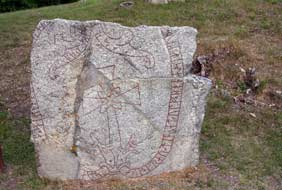 Just along Prästgatan we passed
another of Sigtuna's many runestones, and a stone tower, all that survived of St Lar's church, standing atop a hillock. Turning up the aptly named Runstigen
(Rune Pathway), we passed 2 further surviving rune stone memorials set up to
commemorate family members (Photo 25 - 10~11th century rune stone memorial at Sigtuna); the runic inscriptions translated as: Sven had
this stone erected in memory of his father, and Frödis in memory of her husband
Ulv. God rest his soul and Oleg had this stone erected in
memory of his 2 sisters Tora and Rodvi (see left and right). Across Persgatan we reached the
ruins of St Per's church set prominently on a hilltop and once the royal church,
probably an early cathedral. The beautiful vaulting of the central tower showed
early transition from rounded Romanesque to ogival Gothic arches. Most of the
surviving structure dated from the 13th century making this church
contemporaneous with the earliest parts of our home village church. From here we
walked down to the town's little marina on the shore of Lake Mälaren where
Sunday afternoon visitors gathered for ice creams. We returned along past the
wooden cottages, now twee tourist shops, of Storgatan (Photo 26 - Sigtuna's Storgatan, Sweden's oldest street), completing our tour of
Sigtuna's beautiful churches and runestones, an insightful glimpse into
Sweden's medieval history, to continue our journey on to Uppsala, . Just along Prästgatan we passed
another of Sigtuna's many runestones, and a stone tower, all that survived of St Lar's church, standing atop a hillock. Turning up the aptly named Runstigen
(Rune Pathway), we passed 2 further surviving rune stone memorials set up to
commemorate family members (Photo 25 - 10~11th century rune stone memorial at Sigtuna); the runic inscriptions translated as: Sven had
this stone erected in memory of his father, and Frödis in memory of her husband
Ulv. God rest his soul and Oleg had this stone erected in
memory of his 2 sisters Tora and Rodvi (see left and right). Across Persgatan we reached the
ruins of St Per's church set prominently on a hilltop and once the royal church,
probably an early cathedral. The beautiful vaulting of the central tower showed
early transition from rounded Romanesque to ogival Gothic arches. Most of the
surviving structure dated from the 13th century making this church
contemporaneous with the earliest parts of our home village church. From here we
walked down to the town's little marina on the shore of Lake Mälaren where
Sunday afternoon visitors gathered for ice creams. We returned along past the
wooden cottages, now twee tourist shops, of Storgatan (Photo 26 - Sigtuna's Storgatan, Sweden's oldest street), completing our tour of
Sigtuna's beautiful churches and runestones, an insightful glimpse into
Sweden's medieval history, to continue our journey on to Uppsala, .
On to Uppsala and a closed
campsite: we headed north on minor roads looking forward to settling
into Sunnersta Camping in the southern outskirts of Uppsala, but on arrival it
was clear that the place was no longer open. There was no alternative but to
continue into the city along Dag Hammarskjöld Väg to find the far less attractive
sounding Fyrishov Camping adjacent to a swimming and sports centre closer in to
the city. The long drive into Uppsala took us past a number of modern scientific
institutes and departments of Uppsala University, and just north of the city
centre we reached Fyrishov. First impressions seemed to confirms our fears: a
large swimming complex with an apparently amorphous campsite next door.
With heavy hearts we booked in at reception, but the young staff were pleasantly
welcoming and helpful, suggesting a pitch by the huts and close to the service
building in response to our request for a quiet corner. We reserved the pitch,
but before settling in we needed to find a hypermarket or IKEA to replace our
kettle which had failed. The young staff readily identified a large retail
complex in the NE outskirts of the city and we set off following their
directions around Tycho Hedens Väg ring road. Eventually finding a way into the
acres of car parks, we tried IKEA; this iconic representation of Swedish
entrepreneurial commercialism must surely be able to supply a suitable electric
kettle. But no - household goods of every description and elaboration, but no
electrical goods. With closing time approaching, we tried other stores but
without success: no electric kettles of suitable low power rating. We should
have to try other places tomorrow, and dodging a monumental rain storm, we
returned to the campsite after a day of cultural extremes - medieval Sigtuna to
21st century commercial estates and IKEA.
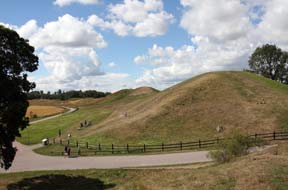 The royal and religious
cult-centre of Gamla Uppsala: our plan was to spend our first day at
Gamla (Old) Uppsala. The modern settlement is now a pleasant suburb of the city,
but across the main railway tracks you enter a wholly mystical world of
Sweden's ancient past. As early as the 3~4th centuries AD, Gamla Uppsala in the
wolds of the River Fyris valley had been an important religious, political and
economic sacred cult centre, the residence of the Swedish kings of the legendary
Yngling dynasty. The earliest of Scandinavian sources speak of the Gamla Uppsala cult site as the seat of royal power, royal
burial ground and site of a great pagan temple, the royal centre of the Svear tribe where from
pre-historic times the king summoned the general assembly (Thing) and a great
religious celebration was held. The late 12th century Danish chronicler Saxo
Grammaticus speaks of Odin himself having his residence at Old Uppsala, and the
13th century Icelandic saga story-teller Snorri Sturluson depicted it as the
home of the Yngling dynasty and of the god Freyr at whose temple here great
sacrificial festivals were held in the god's honour. The 11th century chronicler
Adam of Bremen describes a magnificent golden temple at Old Uppsala where human
sacrifices were made every 9th year in honour of the gods Odin, Thor and Freyr.
Although all the sources were writing 200 years after the events, it was clearly
the seat of royal power of the Svear clan and a major cult centre of the pagan
Norse gods. It is testimony of Gamla Uppsala's religious significance that, with
the Swedes' conversion to Christianity around 1090 AD and the country's receipt
of its first archbishopric in 1164, the first cathedral was located here on the site
of the former pagan temple. Under a clay plateau alongside the present church,
archaeologists have unearthed the remains of a large ceremonial feasting hall,
the centre of the royal kungsgården (royal estate). The royal and religious
cult-centre of Gamla Uppsala: our plan was to spend our first day at
Gamla (Old) Uppsala. The modern settlement is now a pleasant suburb of the city,
but across the main railway tracks you enter a wholly mystical world of
Sweden's ancient past. As early as the 3~4th centuries AD, Gamla Uppsala in the
wolds of the River Fyris valley had been an important religious, political and
economic sacred cult centre, the residence of the Swedish kings of the legendary
Yngling dynasty. The earliest of Scandinavian sources speak of the Gamla Uppsala cult site as the seat of royal power, royal
burial ground and site of a great pagan temple, the royal centre of the Svear tribe where from
pre-historic times the king summoned the general assembly (Thing) and a great
religious celebration was held. The late 12th century Danish chronicler Saxo
Grammaticus speaks of Odin himself having his residence at Old Uppsala, and the
13th century Icelandic saga story-teller Snorri Sturluson depicted it as the
home of the Yngling dynasty and of the god Freyr at whose temple here great
sacrificial festivals were held in the god's honour. The 11th century chronicler
Adam of Bremen describes a magnificent golden temple at Old Uppsala where human
sacrifices were made every 9th year in honour of the gods Odin, Thor and Freyr.
Although all the sources were writing 200 years after the events, it was clearly
the seat of royal power of the Svear clan and a major cult centre of the pagan
Norse gods. It is testimony of Gamla Uppsala's religious significance that, with
the Swedes' conversion to Christianity around 1090 AD and the country's receipt
of its first archbishopric in 1164, the first cathedral was located here on the site
of the former pagan temple. Under a clay plateau alongside the present church,
archaeologists have unearthed the remains of a large ceremonial feasting hall,
the centre of the royal kungsgården (royal estate).
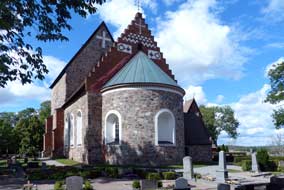 Not only is Gamla Uppsala
associated with the royal power base and religious centre, the sandy ridge had
been a significant burial site for some 2,000 years with many burial mounds of
which traces of some 250 remain. The most prominent burial mounds visible today
are 3 huge 9m high mounds dating back to the 5~6th centuries AD and constructed
along the line of the ridge (see above right). According to ancient mythology, these were the final
resting places of the 3 pagan gods Thor, Odin and Freyr. Legend also has it that
they mark the tombs of 3 ancient kings of the Yngling dynasty Aun, Adil and Egil.
In 1846, to counter a rumour that these symbols of Sweden's ancient historic
royal lineage were in fact natural features of the landscape, King Karl XV had
the eastern mound excavated. A 25m tunnel was driven into the mound's centre
where a clay urn containing cremated human remains and charred fragments of
decorated grave goods were discovered. The remains were indentified as the
cremated bodies of a woman and young man; despite much speculation, no precise
identification has ever been made or which of the 2 interred was the principal
occupant of the tomb. It is quite certain however that they belonged to a royal
dynasty given the majestic scale of the mound. In 1874 the western mound was
excavated, and in the centre similarly cremated human remains and charred grave
goods were found; this time a male, but again no identification was possible
other than their royal status given the lavishness of the grave goods. The
central mound remains unexcavated but it is assumed that it also contains
cremated royal remains. Not only is Gamla Uppsala
associated with the royal power base and religious centre, the sandy ridge had
been a significant burial site for some 2,000 years with many burial mounds of
which traces of some 250 remain. The most prominent burial mounds visible today
are 3 huge 9m high mounds dating back to the 5~6th centuries AD and constructed
along the line of the ridge (see above right). According to ancient mythology, these were the final
resting places of the 3 pagan gods Thor, Odin and Freyr. Legend also has it that
they mark the tombs of 3 ancient kings of the Yngling dynasty Aun, Adil and Egil.
In 1846, to counter a rumour that these symbols of Sweden's ancient historic
royal lineage were in fact natural features of the landscape, King Karl XV had
the eastern mound excavated. A 25m tunnel was driven into the mound's centre
where a clay urn containing cremated human remains and charred fragments of
decorated grave goods were discovered. The remains were indentified as the
cremated bodies of a woman and young man; despite much speculation, no precise
identification has ever been made or which of the 2 interred was the principal
occupant of the tomb. It is quite certain however that they belonged to a royal
dynasty given the majestic scale of the mound. In 1874 the western mound was
excavated, and in the centre similarly cremated human remains and charred grave
goods were found; this time a male, but again no identification was possible
other than their royal status given the lavishness of the grave goods. The
central mound remains unexcavated but it is assumed that it also contains
cremated royal remains.
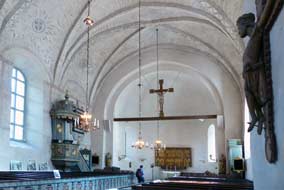 Our visit to Gamla Uppsala
church: from the car park we walked across the busy railway crossing
past the museum and there ahead was the remarkable sight of the line of 3 huge
burial mounds. It is as magnificent a spectacle as the Pyramids, so monumental
are the mounds (Photo 27 - 5~6th centuries AD burial mounds at Gamla Uppsala). Nearer to us was a smaller mound, usually referred to as the
Tinghög (Parliament/Court mound), once the site of the royal gathering (Thing).
The 60kr admission to the Museum included an English-language conducted tour at
3-00pm, so we first walked over to the church beyond the line of mounds. The
first Christian church was a wooden structure built here soon after the 11th
century conversion to Christianity on the site of the former pagan temple to
oust the presence of the pagan gods. This was later replaced by a larger stone
church which was destroyed by fire in 1240 when the nave and transepts of what
became the Swedish diocese's first cathedral were removed leaving just the choir
and central tower; the later addition of sacristy and porch gave the church its
present outer appearance (see above left) (Photo 28 - 13th century former cathedral at Gamla Uppsala). King Our visit to Gamla Uppsala
church: from the car park we walked across the busy railway crossing
past the museum and there ahead was the remarkable sight of the line of 3 huge
burial mounds. It is as magnificent a spectacle as the Pyramids, so monumental
are the mounds (Photo 27 - 5~6th centuries AD burial mounds at Gamla Uppsala). Nearer to us was a smaller mound, usually referred to as the
Tinghög (Parliament/Court mound), once the site of the royal gathering (Thing).
The 60kr admission to the Museum included an English-language conducted tour at
3-00pm, so we first walked over to the church beyond the line of mounds. The
first Christian church was a wooden structure built here soon after the 11th
century conversion to Christianity on the site of the former pagan temple to
oust the presence of the pagan gods. This was later replaced by a larger stone
church which was destroyed by fire in 1240 when the nave and transepts of what
became the Swedish diocese's first cathedral were removed leaving just the choir
and central tower; the later addition of sacristy and porch gave the church its
present outer appearance (see above left) (Photo 28 - 13th century former cathedral at Gamla Uppsala). King
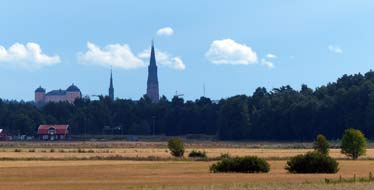 Erik IX of Sweden had his royal court at Gamla
Uppsala and did much to consolidate the new faith in his realm. He was beheaded
in a skirmish with Danes near to Uppsala around 1156 AD; legend has it that
where his head fell a spring came up and he was later canonised as Sweden's
patron saint. His remains now rest in a silver reliquary in Uppsala cathedral
and are carried in royal procession each year on 18 May the anniversary of his
death along the 6km Eriksleden path out to Gamla Uppsala church. As the River
Fyris silted up, the focal point of Uppsala's trading centre moved downstream and
after the 1240 fire, the new cathedral was built in what became the modern city
of Uppsala, originally Östra Aros, and Gamla Uppsala church reduced in status to
parish church (see above right). This must be one of the most breathtaking churches we had visited
in Sweden, truly elegant in its simplicity with beautiful medieval murals lining
the vaulting. Anders Celsius (1701~44), inventor of the centigrade
temperature scale, and Professor of Astronomy at Uppsala University is buried
here with a memorial high on the nave wall. Outside in the churchyard, a large
11th century runestone, Erik IX of Sweden had his royal court at Gamla
Uppsala and did much to consolidate the new faith in his realm. He was beheaded
in a skirmish with Danes near to Uppsala around 1156 AD; legend has it that
where his head fell a spring came up and he was later canonised as Sweden's
patron saint. His remains now rest in a silver reliquary in Uppsala cathedral
and are carried in royal procession each year on 18 May the anniversary of his
death along the 6km Eriksleden path out to Gamla Uppsala church. As the River
Fyris silted up, the focal point of Uppsala's trading centre moved downstream and
after the 1240 fire, the new cathedral was built in what became the modern city
of Uppsala, originally Östra Aros, and Gamla Uppsala church reduced in status to
parish church (see above right). This must be one of the most breathtaking churches we had visited
in Sweden, truly elegant in its simplicity with beautiful medieval murals lining
the vaulting. Anders Celsius (1701~44), inventor of the centigrade
temperature scale, and Professor of Astronomy at Uppsala University is buried
here with a memorial high on the nave wall. Outside in the churchyard, a large
11th century runestone,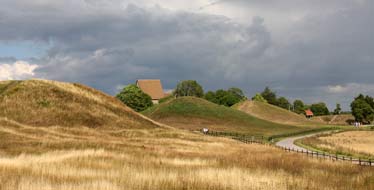 once trimmed as an altar slab, is now set into the
church wall: the runic inscription translates as
Sigvid the traveller to
England raised this stone in memory of his father Vidjärv. once trimmed as an altar slab, is now set into the
church wall: the runic inscription translates as
Sigvid the traveller to
England raised this stone in memory of his father Vidjärv.
The Gamla Uppsala burial mounds
and museum: after sheltering from a passing squally shower, we walked
the circuit of the 3 royal burial mounds (see right) starting along a section of the King
Erik footpath looking across the valley to the distant silhouette of Uppsala's
cathedral with its slender twin spires and Gustav Vasa's Uppsala Slott (see
above left).
Returning to the museum, we joined the guided tour given by an academic
archaeologist who described the theories underlying the mounds' history and the
finds from their excavation, all good stuff with the minimum of legendary
embellishment. After viewing the displays of charred remains and grave goods, it
was again time for us to switch our attention from historical cultural pursuits
to the task of kettle hunting among Uppsala's commercial estates. Back to the
labyrinth of car parks and mega-stores, we eventually managed to find a suitably
small replacement electric kettle which would not blow campsite fuses, and
returned to Fyrishov Camping in the maelstrom of evening traffic.
The university-city of Uppsala
and Carl von Linné's Botanical Gardens: the following day we caught
the #14 bus from outside the Fyrishov swimming complex into Uppsala for our day
in the university-city. Our first visit was to the Botanical Garden developed by
Carl von Linné when he became Professor of Medicine and Botany at Uppsala in
1741. The Garden had originally been laid out by his predecessor holder of the
Chair, Olof Rudbeck in 1655 on an unpromising patch of land which being close to
the river tended to be boggy. Linné, who was born in 1707 to a family of Småland
clergymen, began his studies at Lund University but transferred to Uppsala where
the School of Medicine had a higher reputation thanks to Rudbeck. In a hurry to
gain his medical degree in order to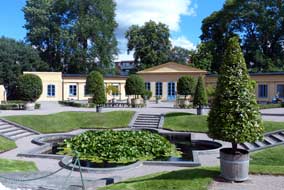 marry his fiancée, Linné submitted his
doctoral thesis at some dubious Dutch university notorious for its sale of
degrees, and returned to Uppsala now a qualified physician. After a period in
practice at Stockholm, he won the Chair of Medicine and Botany at Uppsala in
1741, a post which also held marry his fiancée, Linné submitted his
doctoral thesis at some dubious Dutch university notorious for its sale of
degrees, and returned to Uppsala now a qualified physician. After a period in
practice at Stockholm, he won the Chair of Medicine and Botany at Uppsala in
1741, a post which also held
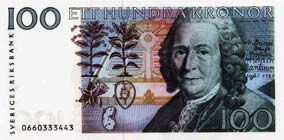 responsibility for the Botanical Gardens, and moved
into its residence with his wife and family in 1743.The Garden had suffered
during a city fire in Rudbeck's old age and was badly neglected. Linné set about
redesigning the gardens along Baroque lines, building an
orangery to conserve vulnerable plants during the cold Swedish winter. During
his tenure, Linné acquired plants from world-wide contacts, using his collection
of over 4,000 different species to support his teaching and research. It was
from this that he developed and published the work for which his name lives on -
the binomial classification system based around the 2-part nomenclature of genus
and species, initially applied to plants and later to animals. The system, with
little change, remains in use today. Linné was ennobled in 1757 becoming Carl
von Linné. He was a popular teacher, considered outrageously unorthodox by his
more staid contemporaries, and a prolific researcher. Linné's portrait and
plants from his Botanical Gardens now appear on Swedish 100kr
banknote (see left). After his death in 1778, his son also Carl became director
of the Botanical Garden but neglected his duties. He was succeeded in 1784 by
his father's pupil Carl Peter Thurnberg who in 1787 persuaded King Gustav III to
donate the gardens of Uppsala Slott to the University as a Botanical Garden. The
old garden was abandoned in 1802 and Linné's orangery became a student club. In
1917 the Swedish Linnaeus Society restored the old garden, using plans and
specifications left by Linné; the University resumed responsibility for upkeep
of the gardens in 1955. responsibility for the Botanical Gardens, and moved
into its residence with his wife and family in 1743.The Garden had suffered
during a city fire in Rudbeck's old age and was badly neglected. Linné set about
redesigning the gardens along Baroque lines, building an
orangery to conserve vulnerable plants during the cold Swedish winter. During
his tenure, Linné acquired plants from world-wide contacts, using his collection
of over 4,000 different species to support his teaching and research. It was
from this that he developed and published the work for which his name lives on -
the binomial classification system based around the 2-part nomenclature of genus
and species, initially applied to plants and later to animals. The system, with
little change, remains in use today. Linné was ennobled in 1757 becoming Carl
von Linné. He was a popular teacher, considered outrageously unorthodox by his
more staid contemporaries, and a prolific researcher. Linné's portrait and
plants from his Botanical Gardens now appear on Swedish 100kr
banknote (see left). After his death in 1778, his son also Carl became director
of the Botanical Garden but neglected his duties. He was succeeded in 1784 by
his father's pupil Carl Peter Thurnberg who in 1787 persuaded King Gustav III to
donate the gardens of Uppsala Slott to the University as a Botanical Garden. The
old garden was abandoned in 1802 and Linné's orangery became a student club. In
1917 the Swedish Linnaeus Society restored the old garden, using plans and
specifications left by Linné; the University resumed responsibility for upkeep
of the gardens in 1955.
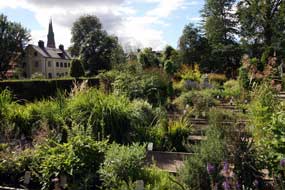 The The
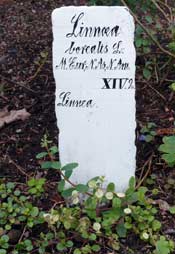 sun was shining brightly as we
began our tour of the gardens laid out by Linné, walking around the beds of
annuals, perennials and marsh-loving plants (Photo 29 and 30 - Linné's Botanic Gardens and Orangery at Uppsala). After our time in the north, it was
clear that all of the plant specimens displayed were from Southern Sweden; only
one noticeable exception was from Lapland detailed later. Admission
included a conducted tour led by a botany graduate who gave an informed
commentary on Linné's life and work, and a visit to the house which had been
occupied by the Linné family for 35 years and where much of his teaching and
research was carried out (Photo 31 - Linné's seminal publication Systema Naturae). All his collections of writings and herbaria were
bought after his death by the London Linnaeus Society and are now held there. At
the conclusion of her presentation, the guide took us out again to a shady
corner of the garden to point out the trailing, small leaved stems of Linnaea
borealis with one of the reproduction name plaques made of Grythyttan slate
from Linné's day (see right). This was the Twin Flower, said to be Linné's favourite plant after he had seen it
during his expedition in Lapland and named in his honour. We were probably
the only ones there who knew intimately of the Twinflower having seen it growing
so often during our own travels in the north (see our Twin Flower photo). Sheila in particular valued
spending time in Carl von Linné's Botanical Garden where the binomial
classification system had been developed, just as 4 years ago we had visited the
monastery garden in Brno in the Czech Republic where Gregor Mendel
conducted his cross-breeding experiments with pea plants and
developed his principles of heredity (see our 2009 log). sun was shining brightly as we
began our tour of the gardens laid out by Linné, walking around the beds of
annuals, perennials and marsh-loving plants (Photo 29 and 30 - Linné's Botanic Gardens and Orangery at Uppsala). After our time in the north, it was
clear that all of the plant specimens displayed were from Southern Sweden; only
one noticeable exception was from Lapland detailed later. Admission
included a conducted tour led by a botany graduate who gave an informed
commentary on Linné's life and work, and a visit to the house which had been
occupied by the Linné family for 35 years and where much of his teaching and
research was carried out (Photo 31 - Linné's seminal publication Systema Naturae). All his collections of writings and herbaria were
bought after his death by the London Linnaeus Society and are now held there. At
the conclusion of her presentation, the guide took us out again to a shady
corner of the garden to point out the trailing, small leaved stems of Linnaea
borealis with one of the reproduction name plaques made of Grythyttan slate
from Linné's day (see right). This was the Twin Flower, said to be Linné's favourite plant after he had seen it
during his expedition in Lapland and named in his honour. We were probably
the only ones there who knew intimately of the Twinflower having seen it growing
so often during our own travels in the north (see our Twin Flower photo). Sheila in particular valued
spending time in Carl von Linné's Botanical Garden where the binomial
classification system had been developed, just as 4 years ago we had visited the
monastery garden in Brno in the Czech Republic where Gregor Mendel
conducted his cross-breeding experiments with pea plants and
developed his principles of heredity (see our 2009 log).
University of Uppsala:
just along the main street, passing the house where Anders Celsius had once
lived and worked, we crossed the river at St Olof's bridge to the University of Uppsala,
which along with
Lund, is Sweden's oldest university founded in 1477 by the Royal Regent Sten the
Elder. The main building of Uppsala University, opened by King Oscar II in 1879,
is used now for lectures, conferences and degree ceremonies (Photo 32 - The main building of Uppsala University).
On the day of our visit a
mineral mining conference was taking place, and delegates spilled out onto the
terrace. We managed to get past the 2 security guards at the entrance and were
able to photograph the magnificent foyer with its decorative cupolas
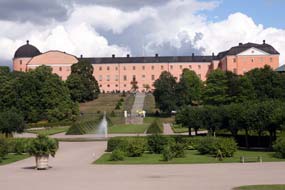 (Photo 33 - Foyer at Uppsala University Main Building). But our
attempts to gain access to the 1,800 seat Aula were thwarted, it has to be said
with (Photo 33 - Foyer at Uppsala University Main Building). But our
attempts to gain access to the 1,800 seat Aula were thwarted, it has to be said
with
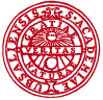 charming and apologetic grace, by another security official; his manner
made the refusal so much more acceptable, albeit still frustrating. Conference
sponsoring firms, including LKAB had stands along the length of the foyer.
Outside on the terrace we were able to photograph the building's elegant façade
which so reminded us of the main building of Tartu University in Southern
Estonia founded in 1632 also by the Swedes under Gustav II Adolfus (see our 2011 log). charming and apologetic grace, by another security official; his manner
made the refusal so much more acceptable, albeit still frustrating. Conference
sponsoring firms, including LKAB had stands along the length of the foyer.
Outside on the terrace we were able to photograph the building's elegant façade
which so reminded us of the main building of Tartu University in Southern
Estonia founded in 1632 also by the Swedes under Gustav II Adolfus (see our 2011 log).
Continuing along Övre Slottsgatan,
we reached the new University Botanical Gardens, donated by Gustav III in 1787 at Thurnberg's request;
the lawns were laid out with pyramidical topiaried yew
trees and led down to the neo-Classical Linnaeum Orangery established in
1807 in memory of Linné on the anniversary of his birth and still used as a
green house. The colonnaded terrace looked back along the length of the formal
gardens to Uppsala Slott up on the hill, or what was left of Gustav Vasa's castle
after the 1702 city fire ravaged most of the original (see left). We walked around the
gardens where many of the species were exotic specimens from distant corners of
the world.
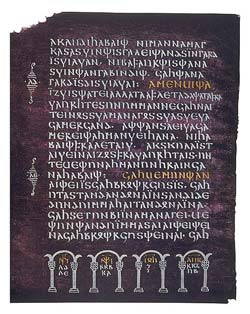
The Codex Argenteus in Uppsala
University Library: we returned along to the austerely monumental
building of Carolina Rediviva, Sweden's oldest and largest university library (Photo 34 - Carolina Rediviva, the Uppsala University library).
Uppsala's original library of Academia Carolina was demolished in 1778 and replaced
in
1819 by the present building, hence its name Carolina Rediviva. Paul tried to
avoid the admission charge by claiming free entry with his Bodleian card
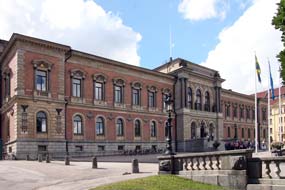 but the
girl on the door was having none of it! Pride of place in the collection of
manuscripts on display was the Codex Argenteus (Silver Book), part of a
manuscript of the 4 gospels written originally by Bishop Wulfila in the 4th century AD
using a script which he devised from
a combination of Byzantine Greek and Gothic runes to render the language of the
Germanic Goths who had occupied Italy after the fall of the Western Roman
Empire. Wulfila was himself partly Goth and was sent as a missionary in the mid 4th century AD to convert the Goths in
the lower reaches of the Danube to Christianity using his translation of the
gospels into the Gothic tongue, rather as Cyril and Methodius later devised the Glagolitic script to translate the Bible to convert the Slavs. Wulfila died in
383 AD and his gospel translation has not survived. Over a century later however,
his original manuscript was copied by scribes
at Ravenna around 520 AD written with silver and gold ink on purple shaded
vellum; one of these copies was the Codex Argenteus (see right). The quality of materials
indicates that it was produced for a person of high rank, most likely the Ostrogoth chieftain Theodoric, who had conquered Italy in 493 AD
and made himself master of the residual Western Roman Empire. The Ostrogoths' rule
in Italy was however short-lived: after Theodoric's death in 526 AD, the
remnants of the Ostrogoth people were scattered and the Gothic language
disappeared for ever. Treasures from the Ostrogoth kingdom, including the Codex
Argenteus, were removed to safety and found their way to the Monastery of Monte
Cassino. Little is known what happened then to the Codex but it was rediscovered
in the 16th century at the
Monastery of Werden near Essen in the Ruhr, and from there found its way to Hradčany Castle in Prague in
Rudolph of Bavaria's collection of artworks and literature. In the last years of the Thirty Years War in 1648, the
Swedes stormed Prague and the Codex was carried off as war booty, eventually
finding its way into the but the
girl on the door was having none of it! Pride of place in the collection of
manuscripts on display was the Codex Argenteus (Silver Book), part of a
manuscript of the 4 gospels written originally by Bishop Wulfila in the 4th century AD
using a script which he devised from
a combination of Byzantine Greek and Gothic runes to render the language of the
Germanic Goths who had occupied Italy after the fall of the Western Roman
Empire. Wulfila was himself partly Goth and was sent as a missionary in the mid 4th century AD to convert the Goths in
the lower reaches of the Danube to Christianity using his translation of the
gospels into the Gothic tongue, rather as Cyril and Methodius later devised the Glagolitic script to translate the Bible to convert the Slavs. Wulfila died in
383 AD and his gospel translation has not survived. Over a century later however,
his original manuscript was copied by scribes
at Ravenna around 520 AD written with silver and gold ink on purple shaded
vellum; one of these copies was the Codex Argenteus (see right). The quality of materials
indicates that it was produced for a person of high rank, most likely the Ostrogoth chieftain Theodoric, who had conquered Italy in 493 AD
and made himself master of the residual Western Roman Empire. The Ostrogoths' rule
in Italy was however short-lived: after Theodoric's death in 526 AD, the
remnants of the Ostrogoth people were scattered and the Gothic language
disappeared for ever. Treasures from the Ostrogoth kingdom, including the Codex
Argenteus, were removed to safety and found their way to the Monastery of Monte
Cassino. Little is known what happened then to the Codex but it was rediscovered
in the 16th century at the
Monastery of Werden near Essen in the Ruhr, and from there found its way to Hradčany Castle in Prague in
Rudolph of Bavaria's collection of artworks and literature. In the last years of the Thirty Years War in 1648, the
Swedes stormed Prague and the Codex was carried off as war booty, eventually
finding its way into the
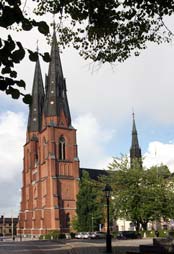 collection of Uppsala University. In the 18th century,
the Codex became a symbol of Swedish nationalism with the Goths promoted as
Sweden's originating peoples the manuscript was bound with an engraved solid silver cover
giving it the name of Codex Argenteus. It is now Uppsala University Library's
prime treasure, although in the dim light of its security case it was difficult
to distinguish any detail of Wulfila's curious script. collection of Uppsala University. In the 18th century,
the Codex became a symbol of Swedish nationalism with the Goths promoted as
Sweden's originating peoples the manuscript was bound with an engraved solid silver cover
giving it the name of Codex Argenteus. It is now Uppsala University Library's
prime treasure, although in the dim light of its security case it was difficult
to distinguish any detail of Wulfila's curious script.
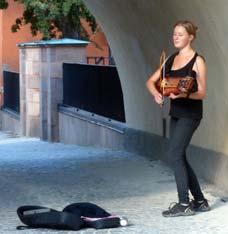 Uppsala Cathedral:
the cathedral in Uppsala begun in the mid-13th century was not completed and
consecrated until 1435, and today is Scandinavia's largest domkyrkan (see left) with its
lofty ornate Gothic nave and ambulatory flanked by a series of memorial chapels
(Photo 35 - Uppsala Cathedral from the University terrace).
Set in the west end floor was the tomb of Linné and his family with a memorial
in one of the chapels. The Baroque pulpit designed by Tessin the Younger was a
most unseemly ornate piece of Baroque extravaganza, and the silver reliquary
containing the remains of St Erik, which is processed to Gamla Uppsala on the
anniversary of his martyrdom, was set in a chapel by the east end ambulatory. A
grand east end chapel contained the ornate sarcophagus of the regally attired
Gustav Vasa along with his queen-consort and ne'er-do-well son Johan III (Photo 36 - Tomb of Gustav Vasa in Uppsala Cathedral). Leaving
the cathedral, we walked down towards the centre pausing to listen to a young
busker playing the traditional nyckel-harpa (literally keyed-fiddle) (see
right) as
seen many weeks ago played by a student in Göteborg; it was such a sweet sound.
Back through the centre passing Uppsala's city hall to the bus station, we caught our bus back out to Fyrishov Camping weary
after such a fulfilling day of learning in this splendid university-city. Uppsala Cathedral:
the cathedral in Uppsala begun in the mid-13th century was not completed and
consecrated until 1435, and today is Scandinavia's largest domkyrkan (see left) with its
lofty ornate Gothic nave and ambulatory flanked by a series of memorial chapels
(Photo 35 - Uppsala Cathedral from the University terrace).
Set in the west end floor was the tomb of Linné and his family with a memorial
in one of the chapels. The Baroque pulpit designed by Tessin the Younger was a
most unseemly ornate piece of Baroque extravaganza, and the silver reliquary
containing the remains of St Erik, which is processed to Gamla Uppsala on the
anniversary of his martyrdom, was set in a chapel by the east end ambulatory. A
grand east end chapel contained the ornate sarcophagus of the regally attired
Gustav Vasa along with his queen-consort and ne'er-do-well son Johan III (Photo 36 - Tomb of Gustav Vasa in Uppsala Cathedral). Leaving
the cathedral, we walked down towards the centre pausing to listen to a young
busker playing the traditional nyckel-harpa (literally keyed-fiddle) (see
right) as
seen many weeks ago played by a student in Göteborg; it was such a sweet sound.
Back through the centre passing Uppsala's city hall to the bus station, we caught our bus back out to Fyrishov Camping weary
after such a fulfilling day of learning in this splendid university-city.
Next week we visit the former silver mines at Sala and
move south to visit the Ånundshög archaeological remains near Västerås, the
former textile town of Norrköping with its Bronze Age rock engravings, the
Swedish Aircraft Museum at Linköping home also of the Saab aircraft industry,
the locks of the Göta Canal, the lovely town of Vadstena home of St Birgitta's
medieval abbey and monastery and Gustav Vasa's castle, and on into the southern
region of Småland to visit the glassworks of the Glasriket region. It will be another busy 2 weeks of exploration so join us
again soon.
Next edition
to be published shortly
|
Sheila and Paul |
Published: 22 December 2013 |
|
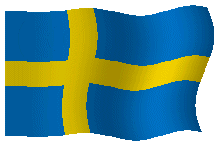
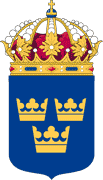
 CAMPING
IN SWEDEN 2013 - the capital city Stockholm, Sweden's oldest town Sigtuna, the
royal and religious cult-centre of Gamla Uppsala, and the university-city of Uppsala:
CAMPING
IN SWEDEN 2013 - the capital city Stockholm, Sweden's oldest town Sigtuna, the
royal and religious cult-centre of Gamla Uppsala, and the university-city of Uppsala: The north~south divide of the Dalälven
river: another familiar connection for us, as we
learnt from the campsite owner, is that the Dalälven river which flows lazily
through the Färnebofjärden lake system is in fact the lower continuation of the
Österdalsälven on whose banks we had camped at Idre, and which flows through
Lake Siljan on to here. The lower Dalälven broadens out into a network of
lakes and meres connected by short stretches of fast-flowing rapids, weaving
across a mosaic of riverside fens, meadows and ancient forests. During the
spring melts, flood plains spread across the flat landscape. The river had
originally flowed into the Mälaran lakes at Stockholm, but when this course was
blocked by glacial moraine, the Dalälven found a new course north-eastwards to
empty into the Baltic near to Gävle. The jagged Färnebofjärden lake system
shore-line encloses more than 2,000 islands, and the landscape of the Dalälven
now forms a natural boundary line between the boreal coniferous trees of the north and
Southern Sweden's broad leafed tree species such as
oak, beech and alder - what the Swedish botanist Carl von Linné called the Limes Norrlandicus (Northlands boundary). It also marks
something of a cultural divide between the north and south of the country.
The north~south divide of the Dalälven
river: another familiar connection for us, as we
learnt from the campsite owner, is that the Dalälven river which flows lazily
through the Färnebofjärden lake system is in fact the lower continuation of the
Österdalsälven on whose banks we had camped at Idre, and which flows through
Lake Siljan on to here. The lower Dalälven broadens out into a network of
lakes and meres connected by short stretches of fast-flowing rapids, weaving
across a mosaic of riverside fens, meadows and ancient forests. During the
spring melts, flood plains spread across the flat landscape. The river had
originally flowed into the Mälaran lakes at Stockholm, but when this course was
blocked by glacial moraine, the Dalälven found a new course north-eastwards to
empty into the Baltic near to Gävle. The jagged Färnebofjärden lake system
shore-line encloses more than 2,000 islands, and the landscape of the Dalälven
now forms a natural boundary line between the boreal coniferous trees of the north and
Southern Sweden's broad leafed tree species such as
oak, beech and alder - what the Swedish botanist Carl von Linné called the Limes Norrlandicus (Northlands boundary). It also marks
something of a cultural divide between the north and south of the country. A day's walking in Färnebofjärden lakeland: Gysinge Bruk
iron works had developed
here in the 17th century taking advantage of the local coincidence of Färnebofjärden's
3 natural features, fast-flowing water to provide power, local iron ore and
plentiful timber supplies for charcoal. After visiting the remains of the Bruk, we spent an interesting day walking out
along the esker-ridge which connected a series of islands projecting southwards
from the campsite into Lake Färnebofjärden. Here we were able to see
direct evidence of this transition landscape supporting a mixture of both
northern and southern plant life. The steep-sided ridge sloping down to the lake
was covered with dark northern pines, but growing among them were small oak and
alder trees, and alongside the typical northern forest ground-cover of bilberry
and lingonberry were patches of southern Lily of the Valley, the plants now well
past flowering but not yet reached the orange berry stage. Our stay at Färnebofjärdens
Camping was a peaceful prelude to the capital city where we should move
tomorrow.
A day's walking in Färnebofjärden lakeland: Gysinge Bruk
iron works had developed
here in the 17th century taking advantage of the local coincidence of Färnebofjärden's
3 natural features, fast-flowing water to provide power, local iron ore and
plentiful timber supplies for charcoal. After visiting the remains of the Bruk, we spent an interesting day walking out
along the esker-ridge which connected a series of islands projecting southwards
from the campsite into Lake Färnebofjärden. Here we were able to see
direct evidence of this transition landscape supporting a mixture of both
northern and southern plant life. The steep-sided ridge sloping down to the lake
was covered with dark northern pines, but growing among them were small oak and
alder trees, and alongside the typical northern forest ground-cover of bilberry
and lingonberry were patches of southern Lily of the Valley, the plants now well
past flowering but not yet reached the orange berry stage. Our stay at Färnebofjärdens
Camping was a peaceful prelude to the capital city where we should move
tomorrow. Our first day in Stockholm: it
poured with rain all night and this morning the waterlogged pitches and traffic
noise made the overcrowding even more miserable. And despite the extortionate
prices, facilities at Ängby Camping were the worst of the entire trip: showers
and toilets were cramped, old-fashioned and grubby and the limited number meant
inevitable queues; the kitchen was poorly equipped and limited wash-ups sinks
again meant queuing. With the weather still gloomily overcast, we set off for
the 800m walk to the Ängbyplan Metro station. Stockholm's Metro system, the
Tunnel-bana (T-bana) provides a fast and efficient means of public transport
around the city (see left); single tickets are expensive (like everything else in
Stockholm) costing 32kr but last for an hour covering both T-bana and buses
(Photo 2 - Stockholm's Metro, the Tunnel-bana). We
followed the journey into the centre on the map noting the pronunciation of
station names as they were announced, and amid the crowds got off at T-Centralen,
a bewildering station complex covering a vast area and with multiple exits. The
first challenge was identifying our location when we emerged feeling even more
disorientated
Our first day in Stockholm: it
poured with rain all night and this morning the waterlogged pitches and traffic
noise made the overcrowding even more miserable. And despite the extortionate
prices, facilities at Ängby Camping were the worst of the entire trip: showers
and toilets were cramped, old-fashioned and grubby and the limited number meant
inevitable queues; the kitchen was poorly equipped and limited wash-ups sinks
again meant queuing. With the weather still gloomily overcast, we set off for
the 800m walk to the Ängbyplan Metro station. Stockholm's Metro system, the
Tunnel-bana (T-bana) provides a fast and efficient means of public transport
around the city (see left); single tickets are expensive (like everything else in
Stockholm) costing 32kr but last for an hour covering both T-bana and buses
(Photo 2 - Stockholm's Metro, the Tunnel-bana). We
followed the journey into the centre on the map noting the pronunciation of
station names as they were announced, and amid the crowds got off at T-Centralen,
a bewildering station complex covering a vast area and with multiple exits. The
first challenge was identifying our location when we emerged feeling even more
disorientated than normally on arrival at a new capital city. Crowds, traffic,
road works and absence of street names left us totally bemused. We struggled to
find a way through unidentified back streets to Drottning-gatan, a narrow and
pedestrianised street crowded with tourists and lined with the tackiest of tat
shops, thoroughly unattractive. We headed towards the Riksbron and parliament
building to emerge by the narrow channel of Norrström, part of Lake Mälaren,
which separates Riddarholmen, the large island now covered by the buildings of
Stockholm's Old Town, Gamla Stan
than normally on arrival at a new capital city. Crowds, traffic,
road works and absence of street names left us totally bemused. We struggled to
find a way through unidentified back streets to Drottning-gatan, a narrow and
pedestrianised street crowded with tourists and lined with the tackiest of tat
shops, thoroughly unattractive. We headed towards the Riksbron and parliament
building to emerge by the narrow channel of Norrström, part of Lake Mälaren,
which separates Riddarholmen, the large island now covered by the buildings of
Stockholm's Old Town, Gamla Stan what would become one of Europe's major powers under
King Gustav II Adolfus in the 17th century. Military defeat by Imperial Russia
in the 18th century Great Northern Wars brought an end to Swedish territorial
expansion in Northern and Eastern Europe, and Stockholm developed politically
and culturally as capital of a smaller Swedish state. During the 19th century it
was still little more than a rural town, becoming overcrowded and lacking all the features of urban life
like piped water supply and drainage. Sweden's neutrality
during WW2 meant the city escaped the bomb damage suffered by other European
capitals, and the post-war Social-Democratic domination in Swedish politics
brought a sustained programme of modernisation. Here we stood by the water's
edge of Lake Mälaren which pervades every corner of the city, still bemused by
the inevitable crowds of tourists in mid-August.
what would become one of Europe's major powers under
King Gustav II Adolfus in the 17th century. Military defeat by Imperial Russia
in the 18th century Great Northern Wars brought an end to Swedish territorial
expansion in Northern and Eastern Europe, and Stockholm developed politically
and culturally as capital of a smaller Swedish state. During the 19th century it
was still little more than a rural town, becoming overcrowded and lacking all the features of urban life
like piped water supply and drainage. Sweden's neutrality
during WW2 meant the city escaped the bomb damage suffered by other European
capitals, and the post-war Social-Democratic domination in Swedish politics
brought a sustained programme of modernisation. Here we stood by the water's
edge of Lake Mälaren which pervades every corner of the city, still bemused by
the inevitable crowds of tourists in mid-August. We extricated ourselves to get
back for the next parliamentary visit.
We extricated ourselves to get
back for the next parliamentary visit.
 the majority party, the current PM (since 2006)
being Frederik Reinfeldt leader of the Moderate Party (see right). Parliament is chaired by
the Speaker, who is also elected by MPs from their number; the current office
holder is Per Westerberg. In October each year, the King, currently Carl XVI
Gustaf, as Head of State officially opens the new parliament, and the PM
announces the government's programme for the coming year. Much of the work of
preparing parliamentary business and refining bills is conducted by the 15 standing
committees.
the majority party, the current PM (since 2006)
being Frederik Reinfeldt leader of the Moderate Party (see right). Parliament is chaired by
the Speaker, who is also elected by MPs from their number; the current office
holder is Per Westerberg. In October each year, the King, currently Carl XVI
Gustaf, as Head of State officially opens the new parliament, and the PM
announces the government's programme for the coming year. Much of the work of
preparing parliamentary business and refining bills is conducted by the 15 standing
committees.
 Stockholm's Gamla Stan (Old Town): re-crossing to Stadsholmen, we walked up through the
narrow streets of the Old Town to Stockholm's cathedral, Storkyrkan set on the
highest point of the island and crammed in among other old buildings. Built
in 1279, it is now the royal church where traditionally Swedish monarchs have
been crowned and married. The narrow street of Trångsund was lined with shops
selling the tackiest of tourist ephemera and thronged with hoards of mindless
tourists among whom mingled some very suspicious-looking characters suggesting
this was prime territory for pickpockets. This led to the more pleasant sloping
open space of Stortorget, one side of which was lined with the Baroque building
of the Nobel Museum, the others with crowded street cafés
(Photo 7 - Stortorget in Gamla Stan). This square had been
the scene of the Danish King Christian II's massacre of Swedish nobility in
1520, known as the 'Stockholm Bloodbath', before he himself was booted out along
with the rest of the Danes by Gustav Vasa's successful Swedish coup in 1623. We
continued along Trångsund, eyeing uneasily the dodgy characters hovering among
the crowds of tourists, to reach the Tyska kyrkan. Built originally for
Stockholm's medieval German merchants, the church had received the usual
extravaganza of Baroque embellishment in the 18th century. On to Järntorget we paused for ice creams
(see left),
before walking down to the quay at Slussen to investigate
ferries across Lake Mälaren to Djurgården for tomorrow.
Stockholm's Gamla Stan (Old Town): re-crossing to Stadsholmen, we walked up through the
narrow streets of the Old Town to Stockholm's cathedral, Storkyrkan set on the
highest point of the island and crammed in among other old buildings. Built
in 1279, it is now the royal church where traditionally Swedish monarchs have
been crowned and married. The narrow street of Trångsund was lined with shops
selling the tackiest of tourist ephemera and thronged with hoards of mindless
tourists among whom mingled some very suspicious-looking characters suggesting
this was prime territory for pickpockets. This led to the more pleasant sloping
open space of Stortorget, one side of which was lined with the Baroque building
of the Nobel Museum, the others with crowded street cafés
(Photo 7 - Stortorget in Gamla Stan). This square had been
the scene of the Danish King Christian II's massacre of Swedish nobility in
1520, known as the 'Stockholm Bloodbath', before he himself was booted out along
with the rest of the Danes by Gustav Vasa's successful Swedish coup in 1623. We
continued along Trångsund, eyeing uneasily the dodgy characters hovering among
the crowds of tourists, to reach the Tyska kyrkan. Built originally for
Stockholm's medieval German merchants, the church had received the usual
extravaganza of Baroque embellishment in the 18th century. On to Järntorget we paused for ice creams
(see left),
before walking down to the quay at Slussen to investigate
ferries across Lake Mälaren to Djurgården for tomorrow. With the sky at last beginning to brighten, we walked along the waterfront past
moored ferries and over-priced quay-side restaurants. With glances up at the
buildings of Gamla Stan crowded onto Stadsholmen's crest, we continued along
towards Slottsbacken which was lined with Tessin's featureless four-square
Royal Palace with Storkyrkan at the crest of the hill. The 2 arms of the Royal
Palace's east wing enclosing gardens stretched down towards the waters of Lake Mälaren.
Tessin had designed his Palace in simple, uniform style to replace the former
Tre Kronor castle which had burnt down during Karl XII's reign at the beginning
of the 18th century. At the top of the steps at the level of the palace gardens,
a blue-uniformed young soldier stood guarding one of the royal flower pots;
after performing a couple of comical prances for the benefit of his sergeant who
came on a tour of inspection, he settled back into his sentry box (see right). At the corner
of the palace, a gushing fountain poured down into a basin looking for all the
world as if someone had just flushed one of the royal loos. The sun at last
broke through lighting the views along towards Gamla Stan
(Photo 8 - Looking towards Gamla Stan from the Royal Palace)
and over the bridge to the Opera House across the
water (Photo 9 - City panorama across Norrström and Strömbron). We crossed to the lawned gardens of the Riksdaghuset, its east façade now
in deep shade, but from under the trees we were able to photograph the now
well-lit Royal Palace (Photo 10 - Royal Palace built by Tessin the Younger in 1754).
With the sky at last beginning to brighten, we walked along the waterfront past
moored ferries and over-priced quay-side restaurants. With glances up at the
buildings of Gamla Stan crowded onto Stadsholmen's crest, we continued along
towards Slottsbacken which was lined with Tessin's featureless four-square
Royal Palace with Storkyrkan at the crest of the hill. The 2 arms of the Royal
Palace's east wing enclosing gardens stretched down towards the waters of Lake Mälaren.
Tessin had designed his Palace in simple, uniform style to replace the former
Tre Kronor castle which had burnt down during Karl XII's reign at the beginning
of the 18th century. At the top of the steps at the level of the palace gardens,
a blue-uniformed young soldier stood guarding one of the royal flower pots;
after performing a couple of comical prances for the benefit of his sergeant who
came on a tour of inspection, he settled back into his sentry box (see right). At the corner
of the palace, a gushing fountain poured down into a basin looking for all the
world as if someone had just flushed one of the royal loos. The sun at last
broke through lighting the views along towards Gamla Stan
(Photo 8 - Looking towards Gamla Stan from the Royal Palace)
and over the bridge to the Opera House across the
water (Photo 9 - City panorama across Norrström and Strömbron). We crossed to the lawned gardens of the Riksdaghuset, its east façade now
in deep shade, but from under the trees we were able to photograph the now
well-lit Royal Palace (Photo 10 - Royal Palace built by Tessin the Younger in 1754). Crossing the bridge to Gustav
Adolfs Torg where fisherman lined the water's edge casting their lines for
salmon in the murky waters flowing along the Norrström channel, there were
splendid views of the Riksdag's East Wing now well-lit by the late afternoon
sun (Photo 11 - East wing of the Riksdag). Back at our day's starting point at Riksbron we were able to photograph the
parliament's West Wing curving façade with the modern parliamentary chamber's
upper storey extension visited earlier. Crossing the Vasabron, there was a
perfect panorama across Lake Mälaren of the entire Riksdag and government
offices lit by the western sun (see left) (Photo 12 - Panorama of the Swedish Parliament Buildings). On the southern side of the bridge we passed the
magnificent 17th century Baroque building of the Riddarhuset in whose Great Hall
the Nobility Estate had met to govern the country before the 1865 constitutional reforms abolished the 4 Estates in favour of a bi-cameral parliament on European
lines (Photo 13 - 17th century Baroque Riddarhuset). Negotiating a way along the pedestrian-unfriendly Centralbron, we
eventually reached the uncharacteristically grubby Gamla Stan T-bana station, to catch our #18 Metro on the Hässelby Strand line back out to the campsite.
Our first day in Stockholm had been a rewarding one with our visit to the
Parliament, but despite the city's attractive watery environment and
grandiose buildings, Gamla Stan had a distinctly unsafe feel with an
ever-present sense of pickpockets loitering among the crowds of tourists;
perhaps it's a sign of the times we now live in.
Crossing the bridge to Gustav
Adolfs Torg where fisherman lined the water's edge casting their lines for
salmon in the murky waters flowing along the Norrström channel, there were
splendid views of the Riksdag's East Wing now well-lit by the late afternoon
sun (Photo 11 - East wing of the Riksdag). Back at our day's starting point at Riksbron we were able to photograph the
parliament's West Wing curving façade with the modern parliamentary chamber's
upper storey extension visited earlier. Crossing the Vasabron, there was a
perfect panorama across Lake Mälaren of the entire Riksdag and government
offices lit by the western sun (see left) (Photo 12 - Panorama of the Swedish Parliament Buildings). On the southern side of the bridge we passed the
magnificent 17th century Baroque building of the Riddarhuset in whose Great Hall
the Nobility Estate had met to govern the country before the 1865 constitutional reforms abolished the 4 Estates in favour of a bi-cameral parliament on European
lines (Photo 13 - 17th century Baroque Riddarhuset). Negotiating a way along the pedestrian-unfriendly Centralbron, we
eventually reached the uncharacteristically grubby Gamla Stan T-bana station, to catch our #18 Metro on the Hässelby Strand line back out to the campsite.
Our first day in Stockholm had been a rewarding one with our visit to the
Parliament, but despite the city's attractive watery environment and
grandiose buildings, Gamla Stan had a distinctly unsafe feel with an
ever-present sense of pickpockets loitering among the crowds of tourists;
perhaps it's a sign of the times we now live in.  Day 2 of our visit to Stockholm - ferry across the harbour to Djurgården to
visit the Vasa Museum: with the sky clearer this morning and
sun shining through the trees, we made our way back over to the Ängbyplan Metro
station. The train was busier on a Saturday morning and we continued 2 further
stops beyond T-Centralen down to Slussen. Emerging from the station, we crossed
the bridge to the southern end of Gamla Stan, glancing up to the wedge of old
buildings and church spires covering Stadsholmen. Our plan was to spend today on
the island of Djurgården, crossing by ferry from Slussen to visit the Museum
devoted to the preserved 17th century royal warship, the Vasa. On
reaching the ferry terminal, it was clear from the long queues that many others,
both tourists and locals, were also heading across to Djurgården most likely to
visit the outdoor museum of Skansen or the Tivoli fairground at Gröna Lunds; there
would be a long wait for the ferry. Pensioners' tickets were available reduced
from 45kr to 30kr, a good price for such a popular journey, and in fact the
queue moved quickly as boat followed boat across the harbour. We were soon
aboard and stood at the forward end for photos of the magnificent panorama of
Gamla Stan as the ferry chugged across the
waters of Lake Mälaren (see right) (Photo 14 - Panorama of Gamla Stan from Djurgården ferry). We did not realise it at the time, but the ferry passed
close to the spot where the warship Vasa had sunk in 1628 just off the
island of Beckholmen. As the ferry drew into the Tivoli dock on Djurgården, we
could hear the screams of fairground visitors being hurtled around on the
roller coasters towering overhead. We followed the quay around and ahead could
see the curious outline of the museum building specially constructed on the site
of a former naval dockyard to house the preserved wooden warship Vasa
with mast-heads seemingly projecting through the roof.
Day 2 of our visit to Stockholm - ferry across the harbour to Djurgården to
visit the Vasa Museum: with the sky clearer this morning and
sun shining through the trees, we made our way back over to the Ängbyplan Metro
station. The train was busier on a Saturday morning and we continued 2 further
stops beyond T-Centralen down to Slussen. Emerging from the station, we crossed
the bridge to the southern end of Gamla Stan, glancing up to the wedge of old
buildings and church spires covering Stadsholmen. Our plan was to spend today on
the island of Djurgården, crossing by ferry from Slussen to visit the Museum
devoted to the preserved 17th century royal warship, the Vasa. On
reaching the ferry terminal, it was clear from the long queues that many others,
both tourists and locals, were also heading across to Djurgården most likely to
visit the outdoor museum of Skansen or the Tivoli fairground at Gröna Lunds; there
would be a long wait for the ferry. Pensioners' tickets were available reduced
from 45kr to 30kr, a good price for such a popular journey, and in fact the
queue moved quickly as boat followed boat across the harbour. We were soon
aboard and stood at the forward end for photos of the magnificent panorama of
Gamla Stan as the ferry chugged across the
waters of Lake Mälaren (see right) (Photo 14 - Panorama of Gamla Stan from Djurgården ferry). We did not realise it at the time, but the ferry passed
close to the spot where the warship Vasa had sunk in 1628 just off the
island of Beckholmen. As the ferry drew into the Tivoli dock on Djurgården, we
could hear the screams of fairground visitors being hurtled around on the
roller coasters towering overhead. We followed the quay around and ahead could
see the curious outline of the museum building specially constructed on the site
of a former naval dockyard to house the preserved wooden warship Vasa
with mast-heads seemingly projecting through the roof. The 1628 sinking of the Vasa
in Stockholm harbour: The Vasa had been constructed on the
orders of King Gustav II Adolfus who, in the arms race with Sweden's arch-enemy
the Danes, wanted the most powerful warship afloat with 72 heavy guns. Vasa
was therefore built to royal specification as the Royal Ship, Sweden's foremost
naval vessel of the day, in the Skeppsgården navy yards by the Dutch
shipwright Henryk Hybertson. 1,000 oak trees were selected for timber for the
huge ship's construction which took 3 years. In early August 1628, the new ship
was ready for her maiden voyage, moored just below the Royal Castle in the
centre of Stockholm, and loaded with ballast, guns and ammunition. Gustav II
Adolfus was as usual away in Prussia fighting with the Poles, and was impatient
to have his new warship join his forces. On Sunday 10 August 1628, crowds lined
the quays to witness the sailing of the Swedish navy's prestigious new warship.
On board were just over 100 of the ship's normal full crew of 300 along with
members of their families who were given permission to join the first part of the
maiden voyage down the archipelago. The occasion of great pomp and ceremony was
described with vivid accuracy by the Danish ambassador in a letter to his
government describing Sweden's new mightily armed warship.
The 1628 sinking of the Vasa
in Stockholm harbour: The Vasa had been constructed on the
orders of King Gustav II Adolfus who, in the arms race with Sweden's arch-enemy
the Danes, wanted the most powerful warship afloat with 72 heavy guns. Vasa
was therefore built to royal specification as the Royal Ship, Sweden's foremost
naval vessel of the day, in the Skeppsgården navy yards by the Dutch
shipwright Henryk Hybertson. 1,000 oak trees were selected for timber for the
huge ship's construction which took 3 years. In early August 1628, the new ship
was ready for her maiden voyage, moored just below the Royal Castle in the
centre of Stockholm, and loaded with ballast, guns and ammunition. Gustav II
Adolfus was as usual away in Prussia fighting with the Poles, and was impatient
to have his new warship join his forces. On Sunday 10 August 1628, crowds lined
the quays to witness the sailing of the Swedish navy's prestigious new warship.
On board were just over 100 of the ship's normal full crew of 300 along with
members of their families who were given permission to join the first part of the
maiden voyage down the archipelago. The occasion of great pomp and ceremony was
described with vivid accuracy by the Danish ambassador in a letter to his
government describing Sweden's new mightily armed warship.

 Our visit to Vasa Museum: we queued and paid what seemed an
expensive admission of 130kr each, and entered the dimly lit hall: there ahead
stood the Vasa, an utterly staggering sight
(Photo 16 - the conserved warship Vasa). Having viewed the film
detailing the sunken warship's discovery and recovery, we joined one of the
English language guided tours to stand alongside the Vasa's open cannon
ports as the guide gave a detailed description of the background to 17th century
naval warfare, the King's insistence on the warship's scale and armaments, the
events of 10 August 1628 leading up to the sinking, the vessel's recovery and
conservation, and a detailed examination of the causes of the loss. By
coincidence today happened also to be 10 August, 385 years to the day since the Vasa's
fateful sinking. We now had a full 4 hours for close examination of the full
scale of the conserved vessel over its full height at 6 levels, from its keel
below the shallow water line, the 2 cannon decks, higher levels giving clear
views of the Vasa's magnificently decorative wooden sculptures, right up
to a gallery overlooking the full length of the upper deck, masts, rigging and
narrow stern castle (Photo 17 - Vasa's deck, masts, rigging and stern-castle). On 4 of the floors, there were also accompanying
exhibitions with detailed multi-lingual commentaries.
Our visit to Vasa Museum: we queued and paid what seemed an
expensive admission of 130kr each, and entered the dimly lit hall: there ahead
stood the Vasa, an utterly staggering sight
(Photo 16 - the conserved warship Vasa). Having viewed the film
detailing the sunken warship's discovery and recovery, we joined one of the
English language guided tours to stand alongside the Vasa's open cannon
ports as the guide gave a detailed description of the background to 17th century
naval warfare, the King's insistence on the warship's scale and armaments, the
events of 10 August 1628 leading up to the sinking, the vessel's recovery and
conservation, and a detailed examination of the causes of the loss. By
coincidence today happened also to be 10 August, 385 years to the day since the Vasa's
fateful sinking. We now had a full 4 hours for close examination of the full
scale of the conserved vessel over its full height at 6 levels, from its keel
below the shallow water line, the 2 cannon decks, higher levels giving clear
views of the Vasa's magnificently decorative wooden sculptures, right up
to a gallery overlooking the full length of the upper deck, masts, rigging and
narrow stern castle (Photo 17 - Vasa's deck, masts, rigging and stern-castle). On 4 of the floors, there were also accompanying
exhibitions with detailed multi-lingual commentaries. bright colours, as well as
being a formidable fighting machine the ship would also have presented a potent
propaganda weapon symbolising the power and glory of Gustav II Adolfus' Swedish
Kingdom. The next 2 levels gave clear views of the 2 decks of cannon ports
which, when opened showed their lions' heads carved decorations, a terrifying
sight to confront enemy vessels (Photo 18 - Vasa's lion head decorated cannon ports). Information panels gave details of the ship's
features and technical aspects of its working. At this level also we could
examine closely the elaborate wooden sculptures lining the bowsprit in the form
of lines of Roman emperors, culminating in huge rampant lions forming the prow
figurehead (Photo 19 - Carved lions figurehead decorating Vasa's prow). Around at the stern, the huge rear panel of the stern castle was one mass
of beautifully preserved wooden sculptures, the centrepiece of which was a
pair of rampant lions embracing the Vasa crest (see left) (Photo 20 - Carved crest decorating Vasa's stern castle). The galleries enabled close
inspection of this formidable artwork's detailed intricacies, and gave the full
impression of the unbelievable height of the masts; only the lower sections had
been preserved making up just one third of the vessel's original full 50m
height. From the top gallery, we could look down the full length of the ship,
revealing just how narrow the stern had been, one of the factors which for a
vessel of this scale and weight of armaments (72 cannon each weighting one ton)
accounted for the Vasa being so top-heavy and vulnerable to keeling over.
bright colours, as well as
being a formidable fighting machine the ship would also have presented a potent
propaganda weapon symbolising the power and glory of Gustav II Adolfus' Swedish
Kingdom. The next 2 levels gave clear views of the 2 decks of cannon ports
which, when opened showed their lions' heads carved decorations, a terrifying
sight to confront enemy vessels (Photo 18 - Vasa's lion head decorated cannon ports). Information panels gave details of the ship's
features and technical aspects of its working. At this level also we could
examine closely the elaborate wooden sculptures lining the bowsprit in the form
of lines of Roman emperors, culminating in huge rampant lions forming the prow
figurehead (Photo 19 - Carved lions figurehead decorating Vasa's prow). Around at the stern, the huge rear panel of the stern castle was one mass
of beautifully preserved wooden sculptures, the centrepiece of which was a
pair of rampant lions embracing the Vasa crest (see left) (Photo 20 - Carved crest decorating Vasa's stern castle). The galleries enabled close
inspection of this formidable artwork's detailed intricacies, and gave the full
impression of the unbelievable height of the masts; only the lower sections had
been preserved making up just one third of the vessel's original full 50m
height. From the top gallery, we could look down the full length of the ship,
revealing just how narrow the stern had been, one of the factors which for a
vessel of this scale and weight of armaments (72 cannon each weighting one ton)
accounted for the Vasa being so top-heavy and vulnerable to keeling over.
 The accompanying exhibitions added
further to visitors' understanding of how such a prestigious vessel's artistic
adornments made the ship as much a propaganda weapon as military, promoting the
image of Gustav II Adolfus as the wise, ruthless but forgiving ruler of the
Kingdom. The displays explained how a large 17th century sailing vessel like the Vasa
would have been rigged, sailed and steered, and included one of her conserved
sails found folded in a lower hold sail locker; despite being one of the
smallest top fore-sails, it still covered a vast area of wall setting in context
just how big the main sails would have been. Details of the Vasa's
armaments showed that the objective of 17th century naval battles was not so
much to sink enemy vessels but disable and capture them or their cannons for
your own use; 3 of the Vasa's conserved original bronze cannon were
displayed each weighing one ton and emblazoned with the royal coat of arms (see
right). The
displays explained the stages of the Vasa's construction in the Skeppsgården
ship-yards, the location of her sinking (which we had passed earlier on the
ferry across the harbour), the discovery of the wreck site, her salvaging and
recovery and all the scientific processes in conserving and reconstructing her
timbers, and finally (and most movingly) the skeletal remains of 10 of those who
drowned at the Vasa's sinking with conjectured background on their lives
and appearance. Despite the seemingly expensive admission charge, we had spent
an engaging 5 hours in the Vasa Museum; the conserved ship itself displayed in
her full glory, with the galleries enabling such intimate viewing, together with
the excellently presented detailed exhibitions, made it one of the finest
museums we had seen in our travels, an indisputable 'must see' for anyone
visiting Stockholm.
The accompanying exhibitions added
further to visitors' understanding of how such a prestigious vessel's artistic
adornments made the ship as much a propaganda weapon as military, promoting the
image of Gustav II Adolfus as the wise, ruthless but forgiving ruler of the
Kingdom. The displays explained how a large 17th century sailing vessel like the Vasa
would have been rigged, sailed and steered, and included one of her conserved
sails found folded in a lower hold sail locker; despite being one of the
smallest top fore-sails, it still covered a vast area of wall setting in context
just how big the main sails would have been. Details of the Vasa's
armaments showed that the objective of 17th century naval battles was not so
much to sink enemy vessels but disable and capture them or their cannons for
your own use; 3 of the Vasa's conserved original bronze cannon were
displayed each weighing one ton and emblazoned with the royal coat of arms (see
right). The
displays explained the stages of the Vasa's construction in the Skeppsgården
ship-yards, the location of her sinking (which we had passed earlier on the
ferry across the harbour), the discovery of the wreck site, her salvaging and
recovery and all the scientific processes in conserving and reconstructing her
timbers, and finally (and most movingly) the skeletal remains of 10 of those who
drowned at the Vasa's sinking with conjectured background on their lives
and appearance. Despite the seemingly expensive admission charge, we had spent
an engaging 5 hours in the Vasa Museum; the conserved ship itself displayed in
her full glory, with the galleries enabling such intimate viewing, together with
the excellently presented detailed exhibitions, made it one of the finest
museums we had seen in our travels, an indisputable 'must see' for anyone
visiting Stockholm. Memorial to the 1994 sinking of
M/S Estonia: we emerged into the late afternoon sunlight and
walked across the quayside gardens to see the memorial to the 852 who lost their
lives in a more recent maritime disaster, the sinking of the ferry Estonia
in 1994 sailing across the Baltic from Tallinn to Stockholm. The memorial takes
the form of a triangular walled enclosure inscribed with the names of those
killed (Photo 21 - Memorial to the 852 victims of 1994 Estonia sinking). In 2011 we had visited the memorial set up on the north coast on the
Estonian island of Hiiumaa looking out across the Baltic to where the Estonia
had sunk (
Memorial to the 1994 sinking of
M/S Estonia: we emerged into the late afternoon sunlight and
walked across the quayside gardens to see the memorial to the 852 who lost their
lives in a more recent maritime disaster, the sinking of the ferry Estonia
in 1994 sailing across the Baltic from Tallinn to Stockholm. The memorial takes
the form of a triangular walled enclosure inscribed with the names of those
killed (Photo 21 - Memorial to the 852 victims of 1994 Estonia sinking). In 2011 we had visited the memorial set up on the north coast on the
Estonian island of Hiiumaa looking out across the Baltic to where the Estonia
had sunk ( Sigtuna, Sweden's oldest
surviving town dating from Viking times: our 3 nights' rent cost
945kr, an amount which would normally buy us at least 4 nights' camping, but the sun was
bright to cheer our departure; we paid in silence but the reckoning was still to
come when we set in train our complaints to the fire authorities and place
the kiss-of-death on this dreadful place in our campsites review. Today we were
heading back north to Uppsala but on the way planned to call at Sigtuna,
Sweden's oldest borough dating back to Viking times. The satnav guided us
through a circuitous labyrinth of motorways
Sigtuna, Sweden's oldest
surviving town dating from Viking times: our 3 nights' rent cost
945kr, an amount which would normally buy us at least 4 nights' camping, but the sun was
bright to cheer our departure; we paid in silence but the reckoning was still to
come when we set in train our complaints to the fire authorities and place
the kiss-of-death on this dreadful place in our campsites review. Today we were
heading back north to Uppsala but on the way planned to call at Sigtuna,
Sweden's oldest borough dating back to Viking times. The satnav guided us
through a circuitous labyrinth of motorways
 eventually leading to the E4
northwards and we joined the intolerantly aggressive traffic. Continuing north,
we turned off into the centre of the little town of Sigtuna. Although today a
small and unassuming town of 8,000 inhabitants, Sigtuna played an important part
in Sweden's early history and lays claims to being Sweden's oldest town. Founded by
King Eric in 980 AD on the shores of a
northern arm of Lake Mälaren, Sigtuna grew in significance as a royal trading
centre to become in the 11th century Sweden's most important town,
eclipsing Stockholm which at that time was still an obscure village. Such an
important royal domain was Sigtuna that Sweden's first coins were minted here
around 1000 AD. In 1230 the Dominican Order founded a monastery here which
played a leading role in Sweden's early medieval ecclesiastical history
producing many archbishops. But by 1300 Sigtuna was overtaken in significance by
fast developing Stockholm, while Sigtuna remained a small town. Despite a
devastating fire in late medieval times, the main church survived and the town
grew again around its original street plan. Its main street Storgatan still
follows its original route, claimed as Sweden's oldest street now under the line
of the modern street, lined with picturesque wooden shops and a regular summer
visitor attraction.
eventually leading to the E4
northwards and we joined the intolerantly aggressive traffic. Continuing north,
we turned off into the centre of the little town of Sigtuna. Although today a
small and unassuming town of 8,000 inhabitants, Sigtuna played an important part
in Sweden's early history and lays claims to being Sweden's oldest town. Founded by
King Eric in 980 AD on the shores of a
northern arm of Lake Mälaren, Sigtuna grew in significance as a royal trading
centre to become in the 11th century Sweden's most important town,
eclipsing Stockholm which at that time was still an obscure village. Such an
important royal domain was Sigtuna that Sweden's first coins were minted here
around 1000 AD. In 1230 the Dominican Order founded a monastery here which
played a leading role in Sweden's early medieval ecclesiastical history
producing many archbishops. But by 1300 Sigtuna was overtaken in significance by
fast developing Stockholm, while Sigtuna remained a small town. Despite a
devastating fire in late medieval times, the main church survived and the town
grew again around its original street plan. Its main street Storgatan still
follows its original route, claimed as Sweden's oldest street now under the line
of the modern street, lined with picturesque wooden shops and a regular summer
visitor attraction. We walked along Storgatan and
found the TIC housed in a former 18th century inn, the Dragon, where the
girl provided us with an informative guide leaflet, highlighting for us the
historical sites and rune stones around the town. As an indication of Sigtuna's
10~11th century wealth and importance, some 150 rune stones have been found in
the area usually set up as memorials alongside ancient roads. Several of these
are scattered around the town's central area, some even in modern gardens. We
set off to walk the circuit. Just off the central square the tiny 18th century Rådhus, said to be Sweden's smallest town hall, was in process of re-roofing and
covered with scaffolding. Just beyond, up Olofsgatan we found the ruins of St
Olof's church founded in the 12~13th centuries, with its sturdily thick stone
walls and short stubby nave, still surrounded by a modern graveyard (see above
left) (Photo 24 - Ruins of 12~13th century St Olof's Church at Sigtuna). At the 1530
Reformation, Gustav Vasa ordered closure of all the country's monasteries and as
a result the Dominican priory was demolished and its church became the
Protestant parish church of St Mary. As a result, the town's
We walked along Storgatan and
found the TIC housed in a former 18th century inn, the Dragon, where the
girl provided us with an informative guide leaflet, highlighting for us the
historical sites and rune stones around the town. As an indication of Sigtuna's
10~11th century wealth and importance, some 150 rune stones have been found in
the area usually set up as memorials alongside ancient roads. Several of these
are scattered around the town's central area, some even in modern gardens. We
set off to walk the circuit. Just off the central square the tiny 18th century Rådhus, said to be Sweden's smallest town hall, was in process of re-roofing and
covered with scaffolding. Just beyond, up Olofsgatan we found the ruins of St
Olof's church founded in the 12~13th centuries, with its sturdily thick stone
walls and short stubby nave, still surrounded by a modern graveyard (see above
left) (Photo 24 - Ruins of 12~13th century St Olof's Church at Sigtuna). At the 1530
Reformation, Gustav Vasa ordered closure of all the country's monasteries and as
a result the Dominican priory was demolished and its church became the
Protestant parish church of St Mary. As a result, the town's
 other churches
including St Olof's fell into ruins. Across the lane the Mariakyrkan stood in
its own graveyard, built of red brick in the 13th century to serve the Dominican
monastery and post-Reformation to become the parish church, a role it still
fulfils, its appearance now much as it was 700 years ago (see above right). A 15th century carved
wooden reredos stood behind the altar with a parade of saints either side of
Christ and Mary Queen of Heaven (see right). It was a truly beautiful church with 15th
century murals lining the vaulting of the north nave. Outside in the graveyard,
an 11th century runestone memorial stood alongside a beautifully recreated herb
garden recalling the former monastery.
other churches
including St Olof's fell into ruins. Across the lane the Mariakyrkan stood in
its own graveyard, built of red brick in the 13th century to serve the Dominican
monastery and post-Reformation to become the parish church, a role it still
fulfils, its appearance now much as it was 700 years ago (see above right). A 15th century carved
wooden reredos stood behind the altar with a parade of saints either side of
Christ and Mary Queen of Heaven (see right). It was a truly beautiful church with 15th
century murals lining the vaulting of the north nave. Outside in the graveyard,
an 11th century runestone memorial stood alongside a beautifully recreated herb
garden recalling the former monastery. Just along Prästgatan we passed
another of Sigtuna's many runestones, and a stone tower, all that survived of St Lar's church, standing atop a hillock. Turning up the aptly named Runstigen
(Rune Pathway), we passed 2 further surviving rune stone memorials set up to
commemorate family members (Photo 25 - 10~11th century rune stone memorial at Sigtuna); the runic inscriptions translated as: Sven had
this stone erected in memory of his father, and Frödis in memory of her husband
Ulv. God rest his soul and Oleg had this stone erected in
memory of his 2 sisters Tora and Rodvi (see left and right). Across Persgatan we reached the
ruins of St Per's church set prominently on a hilltop and once the royal church,
probably an early cathedral. The beautiful vaulting of the central tower showed
early transition from rounded Romanesque to ogival Gothic arches. Most of the
surviving structure dated from the 13th century making this church
contemporaneous with the earliest parts of our home village church. From here we
walked down to the town's little marina on the shore of Lake Mälaren where
Sunday afternoon visitors gathered for ice creams. We returned along past the
wooden cottages, now twee tourist shops, of Storgatan (Photo 26 - Sigtuna's Storgatan, Sweden's oldest street), completing our tour of
Sigtuna's beautiful churches and runestones, an insightful glimpse into
Sweden's medieval history, to continue our journey on to Uppsala, .
Just along Prästgatan we passed
another of Sigtuna's many runestones, and a stone tower, all that survived of St Lar's church, standing atop a hillock. Turning up the aptly named Runstigen
(Rune Pathway), we passed 2 further surviving rune stone memorials set up to
commemorate family members (Photo 25 - 10~11th century rune stone memorial at Sigtuna); the runic inscriptions translated as: Sven had
this stone erected in memory of his father, and Frödis in memory of her husband
Ulv. God rest his soul and Oleg had this stone erected in
memory of his 2 sisters Tora and Rodvi (see left and right). Across Persgatan we reached the
ruins of St Per's church set prominently on a hilltop and once the royal church,
probably an early cathedral. The beautiful vaulting of the central tower showed
early transition from rounded Romanesque to ogival Gothic arches. Most of the
surviving structure dated from the 13th century making this church
contemporaneous with the earliest parts of our home village church. From here we
walked down to the town's little marina on the shore of Lake Mälaren where
Sunday afternoon visitors gathered for ice creams. We returned along past the
wooden cottages, now twee tourist shops, of Storgatan (Photo 26 - Sigtuna's Storgatan, Sweden's oldest street), completing our tour of
Sigtuna's beautiful churches and runestones, an insightful glimpse into
Sweden's medieval history, to continue our journey on to Uppsala, . The royal and religious
cult-centre of Gamla Uppsala: our plan was to spend our first day at
Gamla (Old) Uppsala. The modern settlement is now a pleasant suburb of the city,
but across the main railway tracks you enter a wholly mystical world of
Sweden's ancient past. As early as the 3~4th centuries AD, Gamla Uppsala in the
wolds of the River Fyris valley had been an important religious, political and
economic sacred cult centre, the residence of the Swedish kings of the legendary
Yngling dynasty. The earliest of Scandinavian sources speak of the Gamla Uppsala cult site as the seat of royal power, royal
burial ground and site of a great pagan temple, the royal centre of the Svear tribe where from
pre-historic times the king summoned the general assembly (Thing) and a great
religious celebration was held. The late 12th century Danish chronicler Saxo
Grammaticus speaks of Odin himself having his residence at Old Uppsala, and the
13th century Icelandic saga story-teller Snorri Sturluson depicted it as the
home of the Yngling dynasty and of the god Freyr at whose temple here great
sacrificial festivals were held in the god's honour. The 11th century chronicler
Adam of Bremen describes a magnificent golden temple at Old Uppsala where human
sacrifices were made every 9th year in honour of the gods Odin, Thor and Freyr.
Although all the sources were writing 200 years after the events, it was clearly
the seat of royal power of the Svear clan and a major cult centre of the pagan
Norse gods. It is testimony of Gamla Uppsala's religious significance that, with
the Swedes' conversion to Christianity around 1090 AD and the country's receipt
of its first archbishopric in 1164, the first cathedral was located here on the site
of the former pagan temple. Under a clay plateau alongside the present church,
archaeologists have unearthed the remains of a large ceremonial feasting hall,
the centre of the royal kungsgården (royal estate).
The royal and religious
cult-centre of Gamla Uppsala: our plan was to spend our first day at
Gamla (Old) Uppsala. The modern settlement is now a pleasant suburb of the city,
but across the main railway tracks you enter a wholly mystical world of
Sweden's ancient past. As early as the 3~4th centuries AD, Gamla Uppsala in the
wolds of the River Fyris valley had been an important religious, political and
economic sacred cult centre, the residence of the Swedish kings of the legendary
Yngling dynasty. The earliest of Scandinavian sources speak of the Gamla Uppsala cult site as the seat of royal power, royal
burial ground and site of a great pagan temple, the royal centre of the Svear tribe where from
pre-historic times the king summoned the general assembly (Thing) and a great
religious celebration was held. The late 12th century Danish chronicler Saxo
Grammaticus speaks of Odin himself having his residence at Old Uppsala, and the
13th century Icelandic saga story-teller Snorri Sturluson depicted it as the
home of the Yngling dynasty and of the god Freyr at whose temple here great
sacrificial festivals were held in the god's honour. The 11th century chronicler
Adam of Bremen describes a magnificent golden temple at Old Uppsala where human
sacrifices were made every 9th year in honour of the gods Odin, Thor and Freyr.
Although all the sources were writing 200 years after the events, it was clearly
the seat of royal power of the Svear clan and a major cult centre of the pagan
Norse gods. It is testimony of Gamla Uppsala's religious significance that, with
the Swedes' conversion to Christianity around 1090 AD and the country's receipt
of its first archbishopric in 1164, the first cathedral was located here on the site
of the former pagan temple. Under a clay plateau alongside the present church,
archaeologists have unearthed the remains of a large ceremonial feasting hall,
the centre of the royal kungsgården (royal estate). Not only is Gamla Uppsala
associated with the royal power base and religious centre, the sandy ridge had
been a significant burial site for some 2,000 years with many burial mounds of
which traces of some 250 remain. The most prominent burial mounds visible today
are 3 huge 9m high mounds dating back to the 5~6th centuries AD and constructed
along the line of the ridge (see above right). According to ancient mythology, these were the final
resting places of the 3 pagan gods Thor, Odin and Freyr. Legend also has it that
they mark the tombs of 3 ancient kings of the Yngling dynasty Aun, Adil and Egil.
In 1846, to counter a rumour that these symbols of Sweden's ancient historic
royal lineage were in fact natural features of the landscape, King Karl XV had
the eastern mound excavated. A 25m tunnel was driven into the mound's centre
where a clay urn containing cremated human remains and charred fragments of
decorated grave goods were discovered. The remains were indentified as the
cremated bodies of a woman and young man; despite much speculation, no precise
identification has ever been made or which of the 2 interred was the principal
occupant of the tomb. It is quite certain however that they belonged to a royal
dynasty given the majestic scale of the mound. In 1874 the western mound was
excavated, and in the centre similarly cremated human remains and charred grave
goods were found; this time a male, but again no identification was possible
other than their royal status given the lavishness of the grave goods. The
central mound remains unexcavated but it is assumed that it also contains
cremated royal remains.
Not only is Gamla Uppsala
associated with the royal power base and religious centre, the sandy ridge had
been a significant burial site for some 2,000 years with many burial mounds of
which traces of some 250 remain. The most prominent burial mounds visible today
are 3 huge 9m high mounds dating back to the 5~6th centuries AD and constructed
along the line of the ridge (see above right). According to ancient mythology, these were the final
resting places of the 3 pagan gods Thor, Odin and Freyr. Legend also has it that
they mark the tombs of 3 ancient kings of the Yngling dynasty Aun, Adil and Egil.
In 1846, to counter a rumour that these symbols of Sweden's ancient historic
royal lineage were in fact natural features of the landscape, King Karl XV had
the eastern mound excavated. A 25m tunnel was driven into the mound's centre
where a clay urn containing cremated human remains and charred fragments of
decorated grave goods were discovered. The remains were indentified as the
cremated bodies of a woman and young man; despite much speculation, no precise
identification has ever been made or which of the 2 interred was the principal
occupant of the tomb. It is quite certain however that they belonged to a royal
dynasty given the majestic scale of the mound. In 1874 the western mound was
excavated, and in the centre similarly cremated human remains and charred grave
goods were found; this time a male, but again no identification was possible
other than their royal status given the lavishness of the grave goods. The
central mound remains unexcavated but it is assumed that it also contains
cremated royal remains. Our visit to Gamla Uppsala
church: from the car park we walked across the busy railway crossing
past the museum and there ahead was the remarkable sight of the line of 3 huge
burial mounds. It is as magnificent a spectacle as the Pyramids, so monumental
are the mounds (Photo 27 - 5~6th centuries AD burial mounds at Gamla Uppsala). Nearer to us was a smaller mound, usually referred to as the
Tinghög (Parliament/Court mound), once the site of the royal gathering (Thing).
The 60kr admission to the Museum included an English-language conducted tour at
3-00pm, so we first walked over to the church beyond the line of mounds. The
first Christian church was a wooden structure built here soon after the 11th
century conversion to Christianity on the site of the former pagan temple to
oust the presence of the pagan gods. This was later replaced by a larger stone
church which was destroyed by fire in 1240 when the nave and transepts of what
became the Swedish diocese's first cathedral were removed leaving just the choir
and central tower; the later addition of sacristy and porch gave the church its
present outer appearance (see above left) (Photo 28 - 13th century former cathedral at Gamla Uppsala). King
Our visit to Gamla Uppsala
church: from the car park we walked across the busy railway crossing
past the museum and there ahead was the remarkable sight of the line of 3 huge
burial mounds. It is as magnificent a spectacle as the Pyramids, so monumental
are the mounds (Photo 27 - 5~6th centuries AD burial mounds at Gamla Uppsala). Nearer to us was a smaller mound, usually referred to as the
Tinghög (Parliament/Court mound), once the site of the royal gathering (Thing).
The 60kr admission to the Museum included an English-language conducted tour at
3-00pm, so we first walked over to the church beyond the line of mounds. The
first Christian church was a wooden structure built here soon after the 11th
century conversion to Christianity on the site of the former pagan temple to
oust the presence of the pagan gods. This was later replaced by a larger stone
church which was destroyed by fire in 1240 when the nave and transepts of what
became the Swedish diocese's first cathedral were removed leaving just the choir
and central tower; the later addition of sacristy and porch gave the church its
present outer appearance (see above left) (Photo 28 - 13th century former cathedral at Gamla Uppsala). King
 Erik IX of Sweden had his royal court at Gamla
Uppsala and did much to consolidate the new faith in his realm. He was beheaded
in a skirmish with Danes near to Uppsala around 1156 AD; legend has it that
where his head fell a spring came up and he was later canonised as Sweden's
patron saint. His remains now rest in a silver reliquary in Uppsala cathedral
and are carried in royal procession each year on 18 May the anniversary of his
death along the 6km Eriksleden path out to Gamla Uppsala church. As the River
Fyris silted up, the focal point of Uppsala's trading centre moved downstream and
after the 1240 fire, the new cathedral was built in what became the modern city
of Uppsala, originally Östra Aros, and Gamla Uppsala church reduced in status to
parish church (see above right). This must be one of the most breathtaking churches we had visited
in Sweden, truly elegant in its simplicity with beautiful medieval murals lining
the vaulting. Anders Celsius (1701~44), inventor of the centigrade
temperature scale, and Professor of Astronomy at Uppsala University is buried
here with a memorial high on the nave wall. Outside in the churchyard, a large
11th century runestone,
Erik IX of Sweden had his royal court at Gamla
Uppsala and did much to consolidate the new faith in his realm. He was beheaded
in a skirmish with Danes near to Uppsala around 1156 AD; legend has it that
where his head fell a spring came up and he was later canonised as Sweden's
patron saint. His remains now rest in a silver reliquary in Uppsala cathedral
and are carried in royal procession each year on 18 May the anniversary of his
death along the 6km Eriksleden path out to Gamla Uppsala church. As the River
Fyris silted up, the focal point of Uppsala's trading centre moved downstream and
after the 1240 fire, the new cathedral was built in what became the modern city
of Uppsala, originally Östra Aros, and Gamla Uppsala church reduced in status to
parish church (see above right). This must be one of the most breathtaking churches we had visited
in Sweden, truly elegant in its simplicity with beautiful medieval murals lining
the vaulting. Anders Celsius (1701~44), inventor of the centigrade
temperature scale, and Professor of Astronomy at Uppsala University is buried
here with a memorial high on the nave wall. Outside in the churchyard, a large
11th century runestone, once trimmed as an altar slab, is now set into the
church wall: the runic inscription translates as
Sigvid the traveller to
England raised this stone in memory of his father Vidjärv.
once trimmed as an altar slab, is now set into the
church wall: the runic inscription translates as
Sigvid the traveller to
England raised this stone in memory of his father Vidjärv. marry his fiancée, Linné submitted his
doctoral thesis at some dubious Dutch university notorious for its sale of
degrees, and returned to Uppsala now a qualified physician. After a period in
practice at Stockholm, he won the Chair of Medicine and Botany at Uppsala in
1741, a post which also held
marry his fiancée, Linné submitted his
doctoral thesis at some dubious Dutch university notorious for its sale of
degrees, and returned to Uppsala now a qualified physician. After a period in
practice at Stockholm, he won the Chair of Medicine and Botany at Uppsala in
1741, a post which also held
 responsibility for the Botanical Gardens, and moved
into its residence with his wife and family in 1743.The Garden had suffered
during a city fire in Rudbeck's old age and was badly neglected. Linné set about
redesigning the gardens along Baroque lines, building an
orangery to conserve vulnerable plants during the cold Swedish winter. During
his tenure, Linné acquired plants from world-wide contacts, using his collection
of over 4,000 different species to support his teaching and research. It was
from this that he developed and published the work for which his name lives on -
the binomial classification system based around the 2-part nomenclature of genus
and species, initially applied to plants and later to animals. The system, with
little change, remains in use today. Linné was ennobled in 1757 becoming Carl
von Linné. He was a popular teacher, considered outrageously unorthodox by his
more staid contemporaries, and a prolific researcher. Linné's portrait and
plants from his Botanical Gardens now appear on Swedish 100kr
banknote (see left). After his death in 1778, his son also Carl became director
of the Botanical Garden but neglected his duties. He was succeeded in 1784 by
his father's pupil Carl Peter Thurnberg who in 1787 persuaded King Gustav III to
donate the gardens of Uppsala Slott to the University as a Botanical Garden. The
old garden was abandoned in 1802 and Linné's orangery became a student club. In
1917 the Swedish Linnaeus Society restored the old garden, using plans and
specifications left by Linné; the University resumed responsibility for upkeep
of the gardens in 1955.
responsibility for the Botanical Gardens, and moved
into its residence with his wife and family in 1743.The Garden had suffered
during a city fire in Rudbeck's old age and was badly neglected. Linné set about
redesigning the gardens along Baroque lines, building an
orangery to conserve vulnerable plants during the cold Swedish winter. During
his tenure, Linné acquired plants from world-wide contacts, using his collection
of over 4,000 different species to support his teaching and research. It was
from this that he developed and published the work for which his name lives on -
the binomial classification system based around the 2-part nomenclature of genus
and species, initially applied to plants and later to animals. The system, with
little change, remains in use today. Linné was ennobled in 1757 becoming Carl
von Linné. He was a popular teacher, considered outrageously unorthodox by his
more staid contemporaries, and a prolific researcher. Linné's portrait and
plants from his Botanical Gardens now appear on Swedish 100kr
banknote (see left). After his death in 1778, his son also Carl became director
of the Botanical Garden but neglected his duties. He was succeeded in 1784 by
his father's pupil Carl Peter Thurnberg who in 1787 persuaded King Gustav III to
donate the gardens of Uppsala Slott to the University as a Botanical Garden. The
old garden was abandoned in 1802 and Linné's orangery became a student club. In
1917 the Swedish Linnaeus Society restored the old garden, using plans and
specifications left by Linné; the University resumed responsibility for upkeep
of the gardens in 1955. The
The
 sun was shining brightly as we
began our tour of the gardens laid out by Linné, walking around the beds of
annuals, perennials and marsh-loving plants (Photo 29 and 30 - Linné's Botanic Gardens and Orangery at Uppsala). After our time in the north, it was
clear that all of the plant specimens displayed were from Southern Sweden; only
one noticeable exception was from Lapland detailed later. Admission
included a conducted tour led by a botany graduate who gave an informed
commentary on Linné's life and work, and a visit to the house which had been
occupied by the Linné family for 35 years and where much of his teaching and
research was carried out (Photo 31 - Linné's seminal publication Systema Naturae). All his collections of writings and herbaria were
bought after his death by the London Linnaeus Society and are now held there. At
the conclusion of her presentation, the guide took us out again to a shady
corner of the garden to point out the trailing, small leaved stems of Linnaea
borealis with one of the reproduction name plaques made of Grythyttan slate
from Linné's day (see right). This was the Twin Flower, said to be Linné's favourite plant after he had seen it
during his expedition in Lapland and named in his honour. We were probably
the only ones there who knew intimately of the Twinflower having seen it growing
so often during our own travels in the north (
sun was shining brightly as we
began our tour of the gardens laid out by Linné, walking around the beds of
annuals, perennials and marsh-loving plants (Photo 29 and 30 - Linné's Botanic Gardens and Orangery at Uppsala). After our time in the north, it was
clear that all of the plant specimens displayed were from Southern Sweden; only
one noticeable exception was from Lapland detailed later. Admission
included a conducted tour led by a botany graduate who gave an informed
commentary on Linné's life and work, and a visit to the house which had been
occupied by the Linné family for 35 years and where much of his teaching and
research was carried out (Photo 31 - Linné's seminal publication Systema Naturae). All his collections of writings and herbaria were
bought after his death by the London Linnaeus Society and are now held there. At
the conclusion of her presentation, the guide took us out again to a shady
corner of the garden to point out the trailing, small leaved stems of Linnaea
borealis with one of the reproduction name plaques made of Grythyttan slate
from Linné's day (see right). This was the Twin Flower, said to be Linné's favourite plant after he had seen it
during his expedition in Lapland and named in his honour. We were probably
the only ones there who knew intimately of the Twinflower having seen it growing
so often during our own travels in the north ( (Photo 33 - Foyer at Uppsala University Main Building). But our
attempts to gain access to the 1,800 seat Aula were thwarted, it has to be said
with
(Photo 33 - Foyer at Uppsala University Main Building). But our
attempts to gain access to the 1,800 seat Aula were thwarted, it has to be said
with
 charming and apologetic grace, by another security official; his manner
made the refusal so much more acceptable, albeit still frustrating. Conference
sponsoring firms, including LKAB had stands along the length of the foyer.
Outside on the terrace we were able to photograph the building's elegant façade
which so reminded us of the main building of Tartu University in Southern
Estonia founded in 1632 also by the Swedes under Gustav II Adolfus (
charming and apologetic grace, by another security official; his manner
made the refusal so much more acceptable, albeit still frustrating. Conference
sponsoring firms, including LKAB had stands along the length of the foyer.
Outside on the terrace we were able to photograph the building's elegant façade
which so reminded us of the main building of Tartu University in Southern
Estonia founded in 1632 also by the Swedes under Gustav II Adolfus (
 but the
girl on the door was having none of it! Pride of place in the collection of
manuscripts on display was the Codex Argenteus (Silver Book), part of a
manuscript of the 4 gospels written originally by Bishop Wulfila in the 4th century AD
using a script which he devised from
a combination of Byzantine Greek and Gothic runes to render the language of the
Germanic Goths who had occupied Italy after the fall of the Western Roman
Empire. Wulfila was himself partly Goth and was sent as a missionary in the mid 4th century AD to convert the Goths in
the lower reaches of the Danube to Christianity using his translation of the
gospels into the Gothic tongue, rather as Cyril and Methodius later devised the Glagolitic script to translate the Bible to convert the Slavs. Wulfila died in
383 AD and his gospel translation has not survived. Over a century later however,
his original manuscript was copied by scribes
at Ravenna around 520 AD written with silver and gold ink on purple shaded
vellum; one of these copies was the Codex Argenteus (see right). The quality of materials
indicates that it was produced for a person of high rank, most likely the Ostrogoth chieftain Theodoric, who had conquered Italy in 493 AD
and made himself master of the residual Western Roman Empire. The Ostrogoths' rule
in Italy was however short-lived: after Theodoric's death in 526 AD, the
remnants of the Ostrogoth people were scattered and the Gothic language
disappeared for ever. Treasures from the Ostrogoth kingdom, including the Codex
Argenteus, were removed to safety and found their way to the Monastery of Monte
Cassino. Little is known what happened then to the Codex but it was rediscovered
in the 16th century at the
Monastery of Werden near Essen in the Ruhr, and from there found its way to Hradčany Castle in Prague in
Rudolph of Bavaria's collection of artworks and literature. In the last years of the Thirty Years War in 1648, the
Swedes stormed Prague and the Codex was carried off as war booty, eventually
finding its way into the
but the
girl on the door was having none of it! Pride of place in the collection of
manuscripts on display was the Codex Argenteus (Silver Book), part of a
manuscript of the 4 gospels written originally by Bishop Wulfila in the 4th century AD
using a script which he devised from
a combination of Byzantine Greek and Gothic runes to render the language of the
Germanic Goths who had occupied Italy after the fall of the Western Roman
Empire. Wulfila was himself partly Goth and was sent as a missionary in the mid 4th century AD to convert the Goths in
the lower reaches of the Danube to Christianity using his translation of the
gospels into the Gothic tongue, rather as Cyril and Methodius later devised the Glagolitic script to translate the Bible to convert the Slavs. Wulfila died in
383 AD and his gospel translation has not survived. Over a century later however,
his original manuscript was copied by scribes
at Ravenna around 520 AD written with silver and gold ink on purple shaded
vellum; one of these copies was the Codex Argenteus (see right). The quality of materials
indicates that it was produced for a person of high rank, most likely the Ostrogoth chieftain Theodoric, who had conquered Italy in 493 AD
and made himself master of the residual Western Roman Empire. The Ostrogoths' rule
in Italy was however short-lived: after Theodoric's death in 526 AD, the
remnants of the Ostrogoth people were scattered and the Gothic language
disappeared for ever. Treasures from the Ostrogoth kingdom, including the Codex
Argenteus, were removed to safety and found their way to the Monastery of Monte
Cassino. Little is known what happened then to the Codex but it was rediscovered
in the 16th century at the
Monastery of Werden near Essen in the Ruhr, and from there found its way to Hradčany Castle in Prague in
Rudolph of Bavaria's collection of artworks and literature. In the last years of the Thirty Years War in 1648, the
Swedes stormed Prague and the Codex was carried off as war booty, eventually
finding its way into the
 collection of Uppsala University. In the 18th century,
the Codex became a symbol of Swedish nationalism with the Goths promoted as
Sweden's originating peoples the manuscript was bound with an engraved solid silver cover
giving it the name of Codex Argenteus. It is now Uppsala University Library's
prime treasure, although in the dim light of its security case it was difficult
to distinguish any detail of Wulfila's curious script.
collection of Uppsala University. In the 18th century,
the Codex became a symbol of Swedish nationalism with the Goths promoted as
Sweden's originating peoples the manuscript was bound with an engraved solid silver cover
giving it the name of Codex Argenteus. It is now Uppsala University Library's
prime treasure, although in the dim light of its security case it was difficult
to distinguish any detail of Wulfila's curious script. Uppsala Cathedral:
the cathedral in Uppsala begun in the mid-13th century was not completed and
consecrated until 1435, and today is Scandinavia's largest domkyrkan (see left) with its
lofty ornate Gothic nave and ambulatory flanked by a series of memorial chapels
(Photo 35 - Uppsala Cathedral from the University terrace).
Set in the west end floor was the tomb of Linné and his family with a memorial
in one of the chapels. The Baroque pulpit designed by Tessin the Younger was a
most unseemly ornate piece of Baroque extravaganza, and the silver reliquary
containing the remains of St Erik, which is processed to Gamla Uppsala on the
anniversary of his martyrdom, was set in a chapel by the east end ambulatory. A
grand east end chapel contained the ornate sarcophagus of the regally attired
Gustav Vasa along with his queen-consort and ne'er-do-well son Johan III (Photo 36 - Tomb of Gustav Vasa in Uppsala Cathedral). Leaving
the cathedral, we walked down towards the centre pausing to listen to a young
busker playing the traditional nyckel-harpa (literally keyed-fiddle) (see
right) as
seen many weeks ago played by a student in Göteborg; it was such a sweet sound.
Back through the centre passing Uppsala's city hall to the bus station, we caught our bus back out to Fyrishov Camping weary
after such a fulfilling day of learning in this splendid university-city.
Uppsala Cathedral:
the cathedral in Uppsala begun in the mid-13th century was not completed and
consecrated until 1435, and today is Scandinavia's largest domkyrkan (see left) with its
lofty ornate Gothic nave and ambulatory flanked by a series of memorial chapels
(Photo 35 - Uppsala Cathedral from the University terrace).
Set in the west end floor was the tomb of Linné and his family with a memorial
in one of the chapels. The Baroque pulpit designed by Tessin the Younger was a
most unseemly ornate piece of Baroque extravaganza, and the silver reliquary
containing the remains of St Erik, which is processed to Gamla Uppsala on the
anniversary of his martyrdom, was set in a chapel by the east end ambulatory. A
grand east end chapel contained the ornate sarcophagus of the regally attired
Gustav Vasa along with his queen-consort and ne'er-do-well son Johan III (Photo 36 - Tomb of Gustav Vasa in Uppsala Cathedral). Leaving
the cathedral, we walked down towards the centre pausing to listen to a young
busker playing the traditional nyckel-harpa (literally keyed-fiddle) (see
right) as
seen many weeks ago played by a student in Göteborg; it was such a sweet sound.
Back through the centre passing Uppsala's city hall to the bus station, we caught our bus back out to Fyrishov Camping weary
after such a fulfilling day of learning in this splendid university-city.